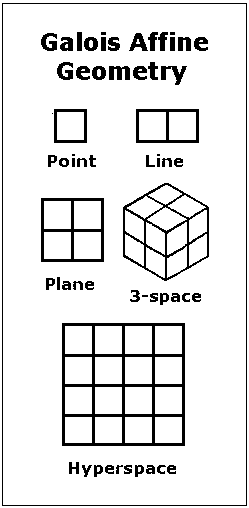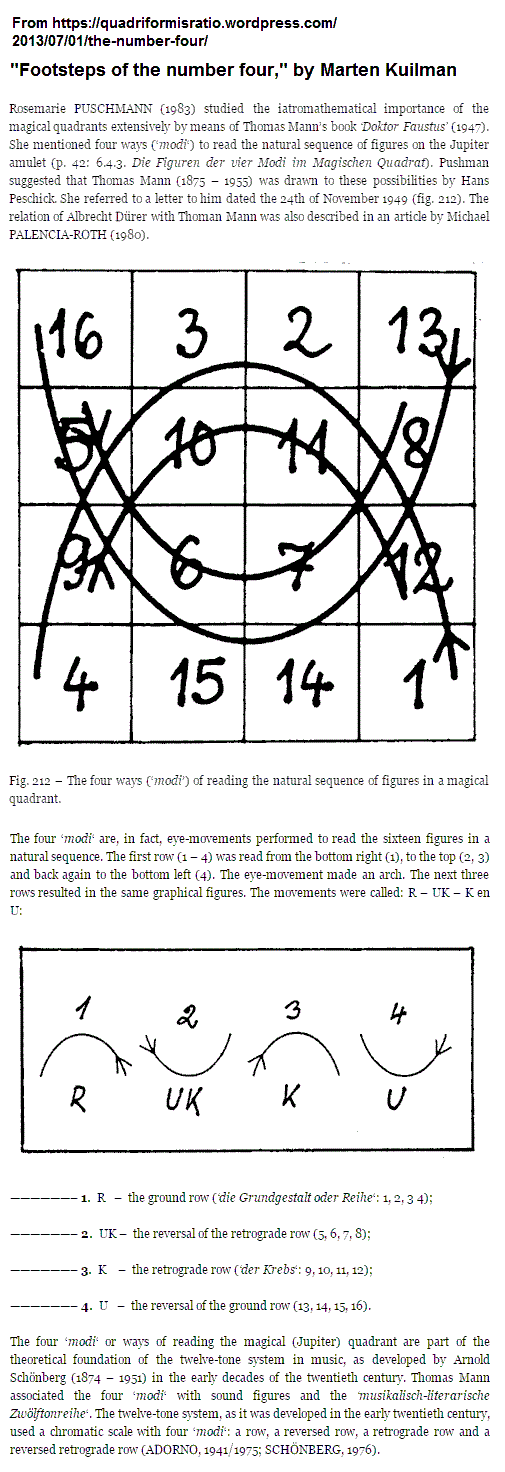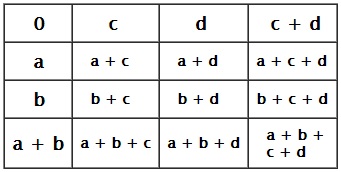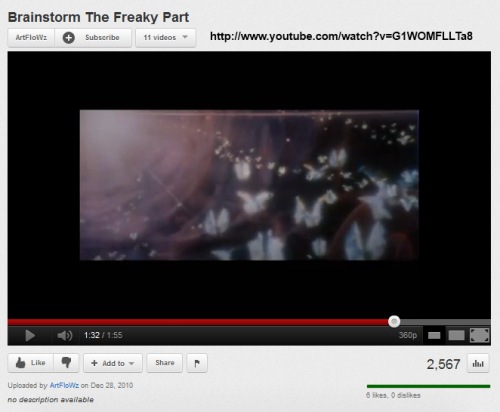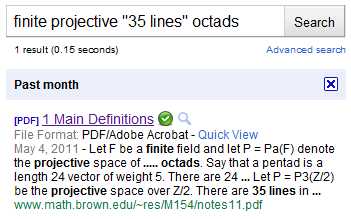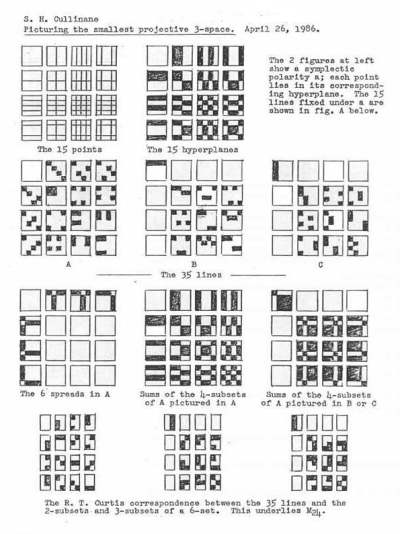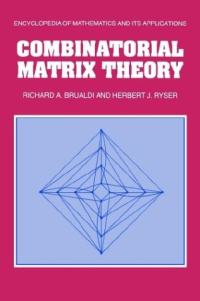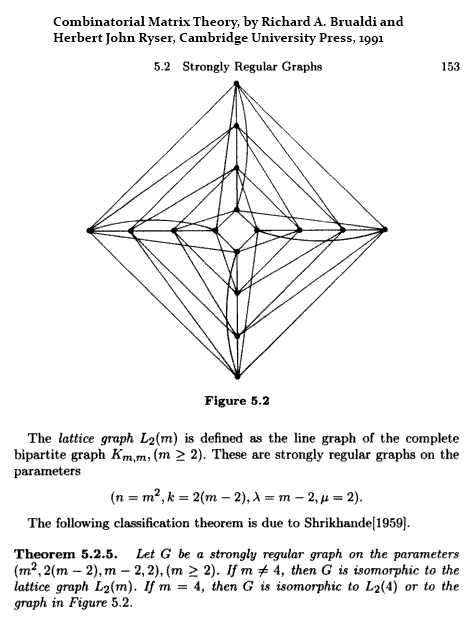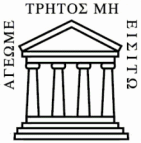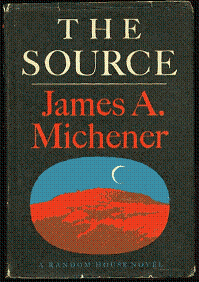(A review)
Friday, August 14, 2015
Discrete Space
Galois space:
Counting symmetries of Galois space:
The reason for these graphic symmetries in affine Galois space —
symmetries of the underlying projective Galois space:
Monday, June 15, 2015
Omega Matrix
See that phrase in this journal.
See also last night's post.

The Greek letter Ω is customarily used to
denote a set that is acted upon by a group.
If the group is the affine group of 322,560
transformations of the four-dimensional
affine space over the two-element Galois
field, the appropriate Ω is the 4×4 grid above.
Sunday, May 17, 2015
Thursday, May 7, 2015
Paradigm for Pedagogues
Illustrations from a post of Feb. 17, 2011:
Plato’s paradigm in the Meno —

Changed paradigm in the diamond theorem (2×2 case) —

Saturday, April 4, 2015
Harrowing of Hell (continued)
Holy Saturday is, according to tradition, the day of
the harrowing of Hell.
Notes:
The above passage on "Die Figuren der vier Modi
im Magischen Quadrat " should be read in the context of
a Log24 post from last year's Devil's Night (the night of
October 30-31). The post, "Structure," indicates that, using
the transformations of the diamond theorem, the notorious
"magic" square of Albrecht Dürer may be transformed
into normal reading order. That order is only one of
322,560 natural reading orders for any 4×4 array of
symbols. The above four "modi" describe another.
Wednesday, April 1, 2015
Manifest O
The title was suggested by
http://benmarcus.com/smallwork/manifesto/.
The "O" of the title stands for the octahedral group.
See the following, from http://finitegeometry.org/sc/map.html —
|
|
An invariance of symmetry The diamond theorem on a 4x4x4 cube, and a sketch of the proof. |
| 83-10-01 | Portrait of O A table of the octahedral group O using the 24 patterns from the 2×2 case of the diamond theorem. |
| 83-10-16 | Study of O A different way of looking at the octahedral group, using cubes that illustrate the 2x2x2 case of the diamond theorem. |
| 84-09-15 | Diamonds and whirls Block designs of a different sort — graphic figures on cubes. See also the University of Exeter page on the octahedral group O. |
Monday, March 2, 2015
Elements of Design
From "How the Guggenheim Got Its Visual Identity,"
by Caitlin Dover, November 4, 2013 —

For the square and half-square in the above logo
as independent design elements, see
the Cullinane diamond theorem.
For the circle and half-circle in the logo,
see Art Wars (July 22, 2012).
For a rectangular space that embodies the name of
the logo's design firm 2×4, see Octad in this journal.
Saturday, February 21, 2015
High and Low Concepts
Steven Pressfield on April 25, 2012:
What exactly is High Concept?
Let’s start with its opposite, low concept.
Low concept stories are personal,
idiosyncratic, ambiguous, often European.
“Well, it’s a sensitive fable about a Swedish
sardine fisherman whose wife and daughter
find themselves conflicted over … ”
ZZZZZZZZ.
Fans of Oslo artist Josefine Lyche know she has
valiantly struggled to find a high-concept approach
to the diamond theorem. Any such approach must,
unfortunately, reckon with the following low
(i.e., not easily summarized) concept —
The Diamond Theorem Correlation:
From left to right …
http://www.log24.com/log/pix14B/140824-Diamond-Theorem-Correlation-1202w.jpg
http://www.log24.com/log/pix14B/140731-Diamond-Theorem-Correlation-747w.jpg
http://www.log24.com/log/pix14B/140824-Picturing_the_Smallest-1986.gif
http://www.log24.com/log/pix14B/140806-ProjPoints.gif
For some backstory, see ProjPoints.gif and "Symplectic Polarity" in this journal.
Wednesday, November 19, 2014
The Eye/Mind Conflict
Harold Rosenberg, "Art and Words,"
The New Yorker , March 29, 1969. From page 110:
"An advanced painting of this century inevitably gives rise
in the spectator to a conflict between his eye and his mind;
as Thomas Hess has pointed out, the fable of the emperor's
new clothes is echoed at the birth of every modemist art
movement. If work in a new mode is to be accepted, the
eye/mind conflict must be resolved in favor of the mind;
that is, of the language absorbed into the work. Of itself,
the eye is incapable of breaking into the intellectual system
that today distinguishes between objects that are art and
those that are not. Given its primitive function of
discriminating among things in shopping centers and on
highways, the eye will recognize a Noland as a fabric
design, a Judd as a stack of metal bins— until the eye's
outrageous philistinism has been subdued by the drone of
formulas concerning breakthroughs in color, space, and
even optical perception (this, too, unseen by the eye, of
course). It is scarcely an exaggeration to say that paintings
are today apprehended with the ears. Miss Barbara Rose,
once a promoter of striped canvases and aluminum boxes,
confesses that words are essential to the art she favored
when she writes, 'Although the logic of minimal art gained
critical respect, if not admiration, its reductiveness allowed
for a relatively limited art experience.' Recent art criticism
has reversed earlier procedures: instead of deriving principles
from what it sees, it teaches the eye to 'see' principles; the
writings of one of America's influential critics often pivot on
the drama of how he failed to respond to a painting or
sculpture the first few times he saw it but, returning to the
work, penetrated the concept that made it significant and
was then able to appreciate it. To qualify as a member of the
art public, an individual must be tuned to the appropriate
verbal reverberations of objects in art galleries, and his
receptive mechanism must be constantly adjusted to oscillate
to new vocabularies."
New vocabulary illustrated:
Graphic Design and a Symplectic Polarity —

Background: The diamond theorem
and a zero system .
Monday, November 3, 2014
The Rhetoric of Abstract Concepts
From a post of June 3, 2013:
New Yorker editor David Remnick at Princeton today
(from a copy of his prepared remarks):
“Finally, speaking of fabric design….”
I prefer Tom and Harold:
Tom Wolfe in The Painted Word —
“I am willing (now that so much has been revealed!)
to predict that in the year 2000, when the Metropolitan
or the Museum of Modern Art puts on the great
retrospective exhibition of American Art 1945-75,
the three artists who will be featured, the three seminal
figures of the era, will be not Pollock, de Kooning, and
Johns-but Greenberg, Rosenberg, and Steinberg.
Up on the walls will be huge copy blocks, eight and a half
by eleven feet each, presenting the protean passages of
the period … a little ‘fuliginous flatness’ here … a little
‘action painting’ there … and some of that ‘all great art
is about art’ just beyond. Beside them will be small
reproductions of the work of leading illustrators of
the Word from that period….”
Harold Rosenberg in The New Yorker (click to enlarge)—
From Gotay and Isenberg, “The Symplectization of Science,”
Gazette des Mathématiciens 54, 59-79 (1992):
“… what is the origin of the unusual name ‘symplectic’? ….
Its mathematical usage is due to Hermann Weyl who,
in an effort to avoid a certain semantic confusion, renamed
the then obscure ‘line complex group’ the ‘symplectic group.’
… the adjective ‘symplectic’ means ‘plaited together’ or ‘woven.’
This is wonderfully apt….”
— Steven H. Cullinane,
diamond theorem illustration
Sunday, November 2, 2014
A Singular Place
"Macy’s Herald Square occupies a singular place
in American retailing." — NY Times today, in print
on page BU1 of the New York edition with the headline:
A Singular Time:
See Remember Me to Herald Square, at noon on
August 21, 2014, and related earlier Log24 posts.
Also on Aug. 21, 2014: from a blog post, 'Tiles,' by
Theo Wright, a British textile designer —
The 24 tile patterns displayed by Wright may be viewed
in their proper mathematical context at …
Friday, October 31, 2014
Structure
Introducing a group of 322,560 affine transformations of Dürer’s ‘Magic’ Square
The four vector-space substructures of digits in 1st, 2nd, 3rd, 4th place,
together with the diamond theorem, indicate that Dürer’s square “minus one”
can be transformed by permutations of rows, columns, and quadrants to a
square with (decimal) digits in the usual numerical order, increasing from
top left to bottom right. Such permutations form a group of order 322,560.
(Continued from Vector Addition in a Finite Field, Twelfth Night, 2013.)
Saturday, September 20, 2014
Symplectic Structure
The fictional zero theorem of Terry Gilliam's current film
by that name should not be confused with the zero system
underlying the diamond theorem.
Sunday, September 14, 2014
Sensibility
Structured gray matter:

Graphic symmetries of Galois space:

The reason for these graphic symmetries in affine Galois space —
symmetries of the underlying projective Galois space:
Tuesday, September 9, 2014
Smoke and Mirrors
This post is continued from a March 12, 2013, post titled
"Smoke and Mirrors" on art in Tromsø, Norway, and from
a June 22, 2014, post on the nineteenth-century
mathematicians Rosenhain and Göpel.
The latter day was the day of death for
mathematician Loren D. Olson, Harvard '64.
For some background on that June 22 post, see the tag
Rosenhain and Göpel in this journal.
Some background on Olson, who taught at the
University of Tromsø, from the American Mathematical
Society yesterday:
Olson died not long after attending the 50th reunion of the
Harvard Class of 1964.
For another connection between that class (also my own)
and Tromsø, see posts tagged "Elegantly Packaged."
This phrase was taken from today's (print)
New York Times review of a new play titled "Smoke."
The phrase refers here to the following "package" for
some mathematical objects that were named after
Rosenhain and Göpel — a 4×4 array —
For the way these objects were packaged within the array
in 1905 by British mathematician R. W. H. T. Hudson, see
a page at finitegometry.org/sc. For the connection to the art
in Tromsø mentioned above, see the diamond theorem.
Sunday, August 31, 2014
Sunday School
The Folding
Cynthia Zarin in The New Yorker , issue dated April 12, 2004—
“Time, for L’Engle, is accordion-pleated. She elaborated,
‘When you bring a sheet off the line, you can’t handle it
until it’s folded, and in a sense, I think, the universe can’t
exist until it’s folded — or it’s a story without a book.’”
The geometry of the 4×4 square array is that of the
3-dimensional projective Galois space PG(3,2).
This space occurs, notably, in the Miracle Octad Generator (MOG)
of R. T. Curtis (submitted to Math. Proc. Camb. Phil. Soc. on
15 June 1974). Curtis did not, however, describe its geometric
properties. For these, see the Cullinane diamond theorem.
Some history:
Curtis seems to have obtained the 4×4 space by permuting,
then “folding” 1×8 binary sequences into 4×2 binary arrays.
The original 1×8 sequences came from the method of Turyn
(1967) described by van Lint in his book Coding Theory
(Springer Lecture Notes in Mathematics, No. 201 , first edition
published in 1971). Two 4×2 arrays form each 4×4 square array
within the MOG. This construction did not suggest any discussion
of the geometric properties of the square arrays.
[Rewritten for clarity on Sept. 3, 2014.]
Thursday, July 17, 2014
Paradigm Shift:
Continuous Euclidean space to discrete Galois space*
Euclidean space:
Counting symmetries in Euclidean space:
Galois space:
Counting symmetries of Galois space:

The reason for these graphic symmetries in affine Galois space —
symmetries of the underlying projective Galois space:
* For related remarks, see posts of May 26-28, 2012.
Sunday, June 8, 2014
Vide
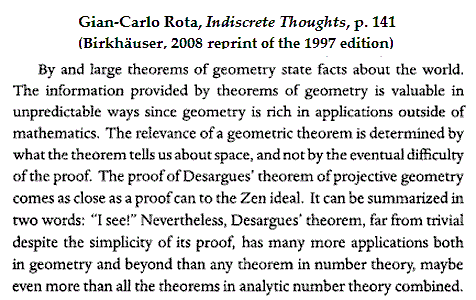
"The relevance of a geometric theorem is determined by what the theorem
tells us about space, and not by the eventual difficulty of the proof."
— Gian-Carlo Rota discussing the theorem of Desargues
What space tells us about the theorem :
In the simplest case of a projective space (as opposed to a plane ),
there are 15 points and 35 lines: 15 Göpel lines and 20 Rosenhain lines.*
The theorem of Desargues in this simplest case is essentially a symmetry
within the set of 20 Rosenhain lines. The symmetry, a reflection
about the main diagonal in the square model of this space, interchanges
10 horizontally oriented (row-based) lines with 10 corresponding
vertically oriented (column-based) lines.
Vide Classical Geometry in Light of Galois Geometry.
* Update of June 9: For a more traditional nomenclature, see (for instance)
R. Shaw, 1995. The "simplest case" link above was added to point out that
the two types of lines named are derived from a natural symplectic polarity
in the space. The square model of the space, apparently first described in
notes written in October and December, 1978, makes this polarity clearly visible:
Wednesday, May 14, 2014
Two -Year College
See last night’s pentagram photo and a post from May 13, 2012.
That post links to a little-known video of a 1972 film.
A speech from the film was used by Oslo artist Josefine Lyche as a
voice-over in her 2011 golden-ratio video (with pentagrams) that she
exhibited along with a large, wall-filling copy of some of my own work.
The speech (see video below) is clearly nonsense.
The patterns* Lyche copied are not.
“Who are you, anyway?”
— Question at 00:41 of 15:00, Rainbow Bridge (Part 5 of 9)
at YouTube, addressed to Baron Bingen as “Mr. Rabbit”
* Patterns exhibited again later, apparently without the Lyche pentagram video.
It turns out, by the way, that Lyche created that video by superimposing
audio from the above “Rainbow Bridge” film onto a section of Disney’s 1959
“Donald in Mathmagic Land” (see 7:17 to 8:57 of the 27:33 Disney video).
Thursday, March 27, 2014
Diamond Space
Definition: A diamond space — informal phrase denoting
a subspace of AG(6, 2), the six-dimensional affine space
over the two-element Galois field.
The reason for the name:
Click to enlarge.
Friday, March 21, 2014
Three Constructions of the Miracle Octad Generator
See also a Log24 post on this subject from Dec. 14, 2013,
especially (scroll down) the update of March 9, 2014.
Related material on the Turyn-Curtis construction
from the University of Cambridge —

— Slide by "Dr. Parker" — Apparently Richard A. Parker —
Lecture 4, "Discovering M24," in slides for lectures 1-8 from lectures
at Cambridge in 2010-2011 on "Sporadic and Related Groups."
See also the Parker lectures of 2012-2013 on the same topic.
A third construction of Curtis's 35 4×6 1976 MOG arrays would use
Cullinane's analysis of the 4×4 subarrays' affine and projective structure,
and point out the fact that Conwell's 1910 correspondence of the 35
4+4-partitions of an 8-set with the 35 lines of the projective 3-space
over the 2-element field, PG(3, 2), is essentially the same correspondence
as that constituting Curtis's 1976 MOG.
See The Diamond Theorem, Finite Relativity, Galois Space,
Generating the Octad Generator, and The Klein Correspondence.
Update of March 22-March 23 —
Adding together as (0,1)-matrices over GF(2) the black parts (black
squares as 1's, all other squares as 0's) of the 35 4×6 arrays of the 1976
Curtis MOG would then reveal* the symmetric role played in octads
by what Curtis called the heavy brick , and so reveal also the action of
S3 on the three Curtis bricks that leaves invariant the set of all 759
octads of the S(5, 8, 24) constructed from the 35 MOG arrays. For more
details of this "by-hand" construction, see Geometry of the 4×4 Square.
For the mathematical properties of the S(5, 8, 24), it is convenient to
have a separate construction (such as Turyn's), not by hand, of the
extended binary Golay code. See the Brouwer preprint quoted above.
* "Then a miracle occurs," as in the classic 1977 Sidney Harris cartoon.
Illustration of array addition from March 23 —
Saturday, March 15, 2014
Tuesday, March 11, 2014
Depth
"… this notion of ‘depth’ is an elusive one
even for a mathematician who can recognize it…."
— G. H. Hardy, A Mathematician's Apology
Part I: An Inch Deep

Part II: An Inch Wide
See a search for "square inch space" in this journal.
See also recent posts with the tag depth.
Thursday, February 6, 2014
The Representation of Minus One
For the late mathematics educator Zoltan Dienes.
“There comes a time when the learner has identified
the abstract content of a number of different games
and is practically crying out for some sort of picture
by means of which to represent that which has been
gleaned as the common core of the various activities.”
— Article by “Melanie” at Zoltan Dienes’s website
Dienes reportedly died at 97 on Jan. 11, 2014.
From this journal on that date —
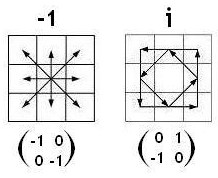
A star figure and the Galois quaternion.
The square root of the former is the latter.
Update of 5:01 PM ET Feb. 6, 2014 —
An illustration by Dienes related to the diamond theorem —
See also the above 15 images in …
… and versions of the 4×4 coordinatization in The 4×4 Relativity Problem
(Jan. 17, 2014).
Friday, January 17, 2014
The 4×4 Relativity Problem
The sixteen-dot square array in yesterday’s noon post suggests
the following remarks.
“This is the relativity problem: to fix objectively a class of
equivalent coordinatizations and to ascertain the group of
transformations S mediating between them.”
— Hermann Weyl, The Classical Groups ,
Princeton University Press, 1946, p. 16
The Galois tesseract appeared in an early form in the journal
Computer Graphics and Art , Vol. 2, No. 1, February 1977—
The 1977 matrix Q is echoed in the following from 2002—

A different representation of Cullinane’s 1977 square model of the
16-point affine geometry over the two-element Galois field GF(2)
is supplied by Conway and Sloane in Sphere Packings, Lattices and Groups
(first published in 1988) :
Here a, b, c, d are basis vectors in the vector 4-space over GF(2).
(For a 1979 version of this vector space, see AMS Abstract 79T-A37.)
See also a 2011 publication of the Mathematical Association of America —
Wednesday, January 8, 2014
Occupy Space
Three Notes on Design
1. From the Museum of Modern Art today—
“It’s a very nice gesture of a kind of new ethos:
To make publicly accessible, unticketed space
that is attractive and has cultural programming,”
Glenn D. Lowry, MoMA’s director, said.
2. From The New York Times today—
3. From myself last December—
Thursday, December 5, 2013
Wednesday, October 16, 2013
Theme and Variations
Josefine Lyche’s large wall version of the twenty-four 2×2 variations
above was apparently offered for sale today in Norway —
Click image for more details and click here for a translation.
Monday, September 30, 2013
Interview with Josefine Lyche
For those who understand spoken Norwegian.
I do not. The interview apparently gives some
background on Lyche’s large wall version of
“The 2×2 Case (Diamond Theorem) II.
(After Steven H. Cullinane)” 2012
Size: 260 x 380 cm
See also this work as displayed at a Kjærlighet til Oslo page.
(Updated March 30, 2014, to replace dead Kjaerlighet link.)
Tuesday, September 3, 2013
“The Stone” Today Suggests…
|
The Philosopher's Gaze , by David Michael Levin, The post-metaphysical question—question for a post-metaphysical phenomenology—is therefore: Can the perceptual field, the ground of perception, be released from our historical compulsion to represent it in a way that accommodates our will to power and its need to totalize and reify the presencing of being? In other words: Can the ground be experienced as ground? Can its hermeneutical way of presencing, i.e., as a dynamic interplay of concealment and unconcealment, be given appropriate respect in the receptivity of a perception that lets itself be appropriated by the ground and accordingly lets the phenomenon of the ground be what and how it is? Can the coming-to-pass of the ontological difference that is constitutive of all the local figure-ground differences taking place in our perceptual field be made visible hermeneutically, and thus without violence to its withdrawal into concealment? But the question concerning the constellation of figure and ground cannot be separated from the question concerning the structure of subject and object. Hence the possibility of a movement beyond metaphysics must also think the historical possibility of breaking out of this structure into the spacing of the ontological difference: différance , the primordial, sensuous, ekstatic écart . As Heidegger states it in his Parmenides lectures, it is a question of "the way historical man belongs within the bestowal of being (Zufügung des Seins ), i.e., the way this order entitles him to acknowledge being and to be the only being among all beings to see the open" (PE* 150, PG** 223. Italics added). We might also say that it is a question of our response-ability, our capacity as beings gifted with vision, to measure up to the responsibility for perceptual responsiveness laid down for us in the "primordial de-cision" (Entscheid ) of the ontological difference (ibid.). To recognize the operation of the ontological difference taking place in the figure-ground difference of the perceptual Gestalt is to recognize the ontological difference as the primordial Riß , the primordial Ur-teil underlying all our perceptual syntheses and judgments—and recognize, moreover, that this rift, this division, decision, and scission, an ekstatic écart underlying and gathering all our so-called acts of perception, is also the only "norm" (ἀρχή ) by which our condition, our essential deciding and becoming as the ones who are gifted with sight, can ultimately be judged. * PE: Parmenides of Heidegger in English— Bloomington: Indiana University Press, 1992 ** PG: Parmenides of Heidegger in German— Gesamtausgabe , vol. 54— Frankfurt am Main: Vittorio Klostermann, 1992 |
Examples of "the primordial Riß " as ἀρχή —

For an explanation in terms of mathematics rather than philosophy,
see the diamond theorem. For more on the Riß as ἀρχή , see
Function Decomposition Over a Finite Field.
Monday, August 12, 2013
Form
The Galois tesseract appeared in an early form in the journal
Computer Graphics and Art , Vol. 2, No. 1, February 1977—
The Galois tesseract is the basis for a representation of the smallest
projective 3-space, PG(3,2), that differs from the representation at
Wolfram Demonstrations Project. For the latter, see yesterday’s post.
The tesseract representation underlies the diamond theorem, illustrated
below in its earliest form, also from the above February 1977 article—
As noted in a more recent version, the group described by
the diamond theorem is also the group of the 35 square
patterns within the 1976 Miracle Octad Generator (MOG) of
R. T. Curtis.
Monday, August 5, 2013
Wikipedia Updates
I added links today in the following Wikipedia articles:
- Diamond theorem (disambiguation page)
- Miracle Octad Generator
- Binary Golay code
The links will probably soon be deleted,
but it seemed worth a try.
Tuesday, July 9, 2013
Vril Chick
Profile picture of "Jo Lyxe" (Josefine Lyche) at Vimeo—

Compare to an image of Vril muse Maria Orsitsch.
From the catalog of a current art exhibition
(25 May – 31 August, 2013) in Norway,
I DE LANGE NÆTTER —
|
Josefine Lyche
Keywords (to help place my artwork in the (See also the original catalog page.) |
Clearly most of this (the non-highlighted parts) was taken
from my webpage Diamond Theory. I suppose I should be
flattered, but I am not thrilled to be associated with the
(apparently fictional) Vril Society.
For some background, see (for instance)
Conspiracy Theories and Secret Societies for Dummies .
Tuesday, June 25, 2013
Lexicon (continued)
Online biography of author Cormac McCarthy—
"… he left America on the liner Sylvania, intending to visit
the home of his Irish ancestors (a King Cormac McCarthy
built Blarney Castle)."
Two Years Ago:
Blarney in The Harvard Crimson—
Melissa C. Wong, illustration for "Atlas to the Text,"
by Nicholas T. Rinehart:

Thirty Years Ago:
Non-Blarney from a rural outpost—
Illustration for the generalized diamond theorem,
by Steven H. Cullinane:
Sunday, June 9, 2013
Sicilian Reflections
(Continued from Sept. 22, 2011)
See Taormina in this journal, and the following photo of "Anne Newton"—
Click photo for context.
Related material:
"Super Overarching" in this journal,
a group of order 322,560, and…

See also the MAA Spectrum program —
— and an excerpt from the above book:
Thursday, June 6, 2013
Review Comment Submitted
The Mathematical Association of America has a
submit-a-review form that apparently allows readers
to comment on previously reviewed books.
This morning I submitted the following comment on
Alexander Bogomolny's March 16, 2012, review of
Martin J. Erickson's Beautiful Mathematics :
In section 5.17, pages 106-108, "A Group of Operations,"
Erickson does not acknowledge any source. This section
is based on the Cullinane diamond theorem. See that
theorem (published in an AMS abstract in 1979) at
PlanetMath.org and EncyclopediaOfMath.org, and
elsewhere on the Web. Details of the proof given by
Erickson may be found in "Binary Coordinate Systems,"
a 1984 article on the Web at
http://finitegeometry.org/sc/gen/coord.html.
If and when the comment may be published, I do not know.
Update of about 6:45 PM ET June 7:
The above comment is now online at the MAA review site.
Update of about 7 PM ET July 29:
The MAA review site's web address was changed, and the
above comment was omitted from the page at the new address.
This has now been corrected.
Tuesday, June 4, 2013
Cover Acts
The Daily Princetonian today:
A different cover act, discussed here Saturday:
See also, in this journal, the Galois tesseract and the Crosswicks Curse.
"There is such a thing as a tesseract." — Crosswicks saying
Saturday, June 1, 2013
Permanence
"What we do may be small, but it has
a certain character of permanence."
— G. H. Hardy, A Mathematician's Apology
The diamond theorem group, published without acknowledgment
of its source by the Mathematical Association of America in 2011—
Tuesday, May 28, 2013
Codes
The hypercube model of the 4-space over the 2-element Galois field GF(2):

The phrase Galois tesseract may be used to denote a different model
of the above 4-space: the 4×4 square.
MacWilliams and Sloane discussed the Miracle Octad Generator
(MOG) of R. T. Curtis further on in their book (see below), but did not
seem to realize in 1977 that the 4×4 structures within the MOG are
based on the Galois-tesseract model of the 4-space over GF(2).

The thirty-five 4×4 structures within the MOG:

Curtis himself first described these 35 square MOG patterns
combinatorially, (as his title indicated) rather than
algebraically or geometrically:

A later book co-authored by Sloane, first published in 1988,
did recognize the 4×4 MOG patterns as based on the 4×4
Galois-tesseract model.
Between the 1977 and 1988 Sloane books came the diamond theorem.
Update of May 29, 2013:
The Galois tesseract appeared in an early form in the journal
Computer Graphics and Art , Vol. 2, No. 1, February 1977
(the year the above MacWilliams-Sloane book was first published):
Tuesday, April 2, 2013
Baker on Configurations
The geometry posts of Sunday and Monday have been
placed in finitegeometry.org as
Classical Geometry in Light of Galois Geometry.
Some background:
See Baker, Principles of Geometry , Vol. II, Note I
(pp. 212-218)—
On Certain Elementary Configurations, and
on the Complete Figure for Pappus's Theorem
and Vol. II, Note II (pp. 219-236)—
On the Hexagrammum Mysticum of Pascal.
Monday's elucidation of Baker's Desargues-theorem figure
treats the figure as a 154203 configuration (15 points,
4 lines on each, and 20 lines, 3 points on each).
Such a treatment is by no means new. See Baker's notes
referred to above, and
"The Complete Pascal Figure Graphically Presented,"
a webpage by J. Chris Fisher and Norma Fuller.
What is new in the Monday Desargues post is the graphic
presentation of Baker's frontispiece figure using Galois geometry :
specifically, the diamond theorem square model of PG(3,2).
See also Cremona's kernel, or nocciolo :

Baker on Cremona's approach to Pascal—
"forming, in Cremona's phrase, the nocciolo of the whole."

A related nocciolo :
Click on the nocciolo for some
geometric background.
Tuesday, March 19, 2013
Mathematics and Narrative (continued)
Angels & Demons meet Hudson Hawk
Dan Brown's four-elements diamond in Angels & Demons :

The Leonardo Crystal from Hudson Hawk :

Mathematics may be used to relate (very loosely)
Dan Brown's fanciful diamond figure to the fanciful
Leonardo Crystal from Hudson Hawk …
-
Compare Brown's fictional Illuminati Diamond to the
nonfictional figures in The Diamond Theorem and
Theme and Variations. -
Compare the fictional Leonardo Crystal to Hudson's
nonfictional desmic system of tetrahedra (above), and
see, in Rosenhain and Göpel Tetrads in PG(3,2), how
the diamond theorem is related to Hudson's work.
For the tetrads ' relationship to tetrahedra , see
Hudson's own book.
"Giving himself a head rub, Hawk bears down on
the three oddly malleable objects. He TANGLES
and BENDS and with a loud SNAP, puts them together,
forming the Crystal from the opening scene."
— A screenplay of Hudson Hawk
Happy birthday to Bruce Willis.
Saturday, March 16, 2013
The Crosswicks Curse
From the prologue to the new Joyce Carol Oates
novel Accursed—
"This journey I undertake with such anticipation
is not one of geographical space but one of Time—
for it is the year 1905 that is my destination.
1905!—the very year of the Curse."
Today's previous post supplied a fanciful link
between the Crosswicks Curse of Oates and
the Crosswicks tesseract of Madeleine L'Engle.
The Crosswicks Curse according to L'Engle
in her classic 1962 novel A Wrinkle in Time —
"There is such a thing as a tesseract."
A tesseract is a 4-dimensional hypercube that
(as pointed out by Coxeter in 1950) may also
be viewed as a 4×4 array (with opposite edges
identified).
Meanwhile, back in 1905…
For more details, see how the Rosenhain and Göpel tetrads occur naturally
in the diamond theorem model of the 35 lines of the 15-point projective
Galois space PG(3,2).
See also Conwell in this journal and George Macfeely Conwell in the
honors list of the Princeton Class of 1905.
Tuesday, March 12, 2013
Smoke and Mirrors
Sistine Chapel Smoke
Tromso Kunsthall Mirrors
Background for the smoke image:
A remark by Michelangelo in a 2007 post, High Concept.
Background for the mirrors image:
Note the publication date— Mar. 10, 2013.
Tuesday, February 19, 2013
Configurations
Yesterday's post Permanence dealt with the cube
as a symmetric model of the finite projective plane
PG(2,3), which has 13 points and 13 lines. The points
and lines of the finite geometry occur in the cube as
the 13 axes of symmetry and the 13 planes through
the center perpendicular to those axes. If the three
axes lying in a plane that cuts the cube in a hexagon
are supplemented by the axis perpendicular to that
plane, each plane is associated with four axes and,
dually, each axis is associated with four planes.
My web page on this topic, Cubist Geometries, was
written on February 27, 2010, and first saved to the
Internet Archive on Oct. 4, 2010.
For a more recent treatment of this topic that makes
exactly the same points as the 2010 page, see p. 218
of Configurations from a Graphical Viewpoint , by
Tomaž Pisanski and Brigitte Servatius, published by
Springer on Sept. 23, 2012 (date from both Google
Books and Amazon.com):
For a similar 1998 treatment of the topic, see Burkard Polster's
A Geometrical Picture Book (Springer, 1998), pp. 103-104.
The Pisanski-Servatius book reinforces my argument of Jan. 13, 2013,
that the 13 planes through the cube's center that are perpendicular
to the 13 axes of symmetry of the cube should be called the cube's
symmetry planes , contradicting the usual use of of that term.
That argument concerns the interplay between Euclidean and
Galois geometry. Pisanski and Servatius (and, in 1998, Polster)
emphasize the Euclidean square and cube as guides* to
describing the structure of a Galois space. My Jan. 13 argument
uses Galois structures as a guide to re-describing those of Euclid .
(For a similar strategy at a much more sophisticated level,
see a recent Harvard Math Table.)
Related material: Remarks on configurations in this journal
during the month that saw publication of the Pisanski-Servatius book.
* Earlier guides: the diamond theorem (1978), similar theorems for
2x2x2 (1984) and 4x4x4 cubes (1983), and Visualizing GL(2,p)
(1985). See also Spaces as Hypercubes (2012).
Wednesday, January 2, 2013
PlanetMath link
Update of May 27, 2013:
The post below is now outdated. See
http://planetmath.org/cullinanediamondtheorem .
__________________________________________________________________
The brief note on the diamond theorem at PlanetMath
disappeared some time ago. Here is a link to its
current URL: http://planetmath.org/?op=getobj;from=lec;id=49.
Update of 3 PM ET Jan. 2, 2013—
Another item recovered from Internet storage:
Click on the Monthly page for some background.
Monday, December 10, 2012
Review of Leonardo Article
Review of an often-cited Leonardo article that is
now available for purchase online…
|
The Tiling Patterns of Sebastien Truchet Authors: Cyril Stanley Smith and Pauline Boucher
Source: Leonardo , Vol. 20, No. 4, Published by: The MIT Press Stable URL: http://www.jstor.org/stable/1578535 . |
Smith and Boucher give a well-illustrated account of
the early history of Truchet tiles, but their further remarks
on the mathematics underlying patterns made with
these tiles (see the diamond theorem* of 1976) are
worthless.
For instance…
Excerpt from pages 383-384—
"A detailed analysis of Truchet's
patterns touches upon the most fundamental
questions of the relation between
mathematical formalism and the structure
of the material world. Separations
between regions differing in density
require that nothing be as important as
something and that large and small cells of
both must coexist. The aggregation of
unitary choice of directional distinction
at interfaces lies at the root of all being
and becoming."
* This result is about Truchet-tile patterns, but the
underlying mathematics was first discovered by
investigating superimposed patterns of half-circles .
See Half-Circle Patterns at finitegeometry.org.
Saturday, December 8, 2012
Defining the Contest…
… Chomsky vs. Santa
From a New Yorker weblog yesterday—
"Happy Birthday, Noam Chomsky." by Gary Marcus—
"… two titans facing off, with Chomsky, as ever,
defining the contest"
"Chomsky sees himself, correctly, as continuing
a conversation that goes back to Plato, especially
the Meno dialogue, in which a slave boy is
revealed by Socrates to know truths about
geometry that he hadn’t realized he knew."
See Meno Diamond in this journal. For instance, from
the Feast of Saint Nicholas (Dec. 6th) this year—
The Meno Embedding

For related truths about geometry, see the diamond theorem.
For a related contest of language theory vs. geometry,
see pattern theory (Sept. 11, 16, and 17, 2012).
See esp. the Sept. 11 post, on a Royal Society paper from July 2012
claiming that
"With the results presented here, we have taken the first steps
in decoding the uniquely human fascination with visual patterns,
what Gombrich* termed our ‘sense of order.’ "
The sorts of patterns discussed in the 2012 paper —

"First steps"? The mathematics underlying such patterns
was presented 35 years earlier, in Diamond Theory.
* See Gombrich-Douat in this journal.
Thursday, November 29, 2012
Conceptual Art
Quotes from the Bremen site
http://dada.compart-bremen.de/ —

" 'compArt | center of excellence digital art' is a project
at the University of Bremen, Germany. It is dedicated
to research and development in computing, design,
and teaching. It is supported by Rudolf Augstein Stiftung,
the University of Bremen, and Karin und Uwe Hollweg Stiftung."
See also Stiftung in this journal.
Sunday, November 18, 2012
Sermon
Happy birthday to…

Today's sermon, by Marie-Louise von Franz—
For more on the modern physicist analyzed by von Franz,
see The Innermost Kernel , by Suzanne Gieser.
Another modern physicist, Niels Bohr, died
on this date in 1962…
|
The circle above is marked with a version For the square, see the diamond theorem. "Two things of opposite natures seem to depend — Wallace Stevens, |
Wednesday, October 10, 2012
Ambiguation
Wikipedia disambiguation page—

"When you come to a fork in the road…"

For another "shifting reality that shimmered
in a multiplicity of facets," see The Diamond Theorem.
Midnight
Disambiguation
A new Wikipedia disambiguation page for "Diamond theorem"—
History of the above new Wikipedia page—
See also a Google search for "diamond theorem."
Friday, August 24, 2012
Formal Pattern
(Continued from In Memoriam (Aug. 22), Chapman's Homer (Aug. 23),
and this morning's Colorful Tale)
An informative, but undated, critique of the late Marvin W. Meyer
by April D. DeConick at the website of the Society of Biblical Literature
appeared in more popular form in an earlier New York Times
op-ed piece, "Gospel Truth," dated Dec. 1, 2007.
A check, in accord with Jungian synchronicity, of this journal
on that date yields a quotation from Plato's Phaedrus —
"The soul or animate being has the care of the inanimate."
Related verses from T. S. Eliot's Four Quartets —
"The detail of the pattern is movement."
"So we moved, and they, in a formal pattern."
Some background from pure mathematics (what the late
William P. Thurston called "the theory of formal patterns")—
Sunday, July 29, 2012
The Galois Tesseract
The three parts of the figure in today's earlier post "Defining Form"—

— share the same vector-space structure:
| 0 | c | d | c + d |
| a | a + c | a + d | a + c + d |
| b | b + c | b + d | b + c + d |
| a + b | a + b + c | a + b + d | a + b + c + d |
(This vector-space a b c d diagram is from Chapter 11 of
Sphere Packings, Lattices and Groups , by John Horton
Conway and N. J. A. Sloane, first published by Springer
in 1988.)
The fact that any 4×4 array embodies such a structure was implicit in
the diamond theorem (February 1979). Any 4×4 array, regarded as
a model of the finite geometry AG(4, 2), may be called a Galois tesseract.
(So called because of the Galois geometry involved, and because the
16 cells of a 4×4 array with opposite edges identified have the same
adjacency pattern as the 16 vertices of a tesseract (see, for instance,
Coxeter's 1950 "Self-Dual Configurations and Regular Graphs," figures
5 and 6).)
A 1982 discussion of a more abstract form of AG(4, 2):

Source:

The above 1982 remarks by Brouwer may or may not have influenced
the drawing of the above 1988 Conway-Sloane diagram.
Sunday, May 13, 2012
Children of Light*
An earlier verse in 1 John—
1 John 1:5 "This then is the message
which we have heard of him,
and declare unto you, that God is light,
and in him is no darkness at all."
Catechism from a different cult—
"Who are you, anyway?"
— Question at 00:41 of 15:01,
Rainbow Bridge (Part 5 of 9) at YouTube
See also the video accompanying artist Josefine Lyche's version
of the 2×2 case of the diamond theorem.
* Title of a Robert Stone novel
Thursday, February 9, 2012
ART WARS continued
On the Complexity of Combat—
The above article (see original pdf), clearly of more
theoretical than practical interest, uses the concept
of "symmetropy" developed by some Japanese
researchers.
For some background from finite geometry, see
Symmetry of Walsh Functions. For related posts
in this journal, see Smallest Perfect Universe.
Update of 7:00 PM EST Feb. 9, 2012—
Background on Walsh-function symmetry in 1982—
(Click image to enlarge. See also original pdf.)
Note the somewhat confusing resemblance to
a four-color decomposition theorem
used in the proof of the diamond theorem.
Saturday, December 31, 2011
The Uploading
"Design is how it works." — Steve Jobs
From a commercial test-prep firm in New York City—
From the date of the above uploading—
|
|
From a New Year's Day, 2012, weblog post in New Zealand—

From Arthur C. Clarke, an early version of his 2001 monolith—
"So they left a sentinel, one of millions they have scattered
throughout the Universe, watching over all worlds with the
promise of life. It was a beacon that down the ages has been
patiently signaling the fact that no one had discovered it.
Perhaps you understand now why that crystal pyramid was set…."
The numerical (not crystal) pyramid above is related to a sort of
mathematical block design known as a Steiner system.
For its relationship to the graphic block design shown above,
see the webpages Block Designs and The Diamond Theorem
as well as The Galois Tesseract and R. T. Curtis's classic paper
"A New Combinatorial Approach to M24," which contains the following
version of the above numerical pyramid—
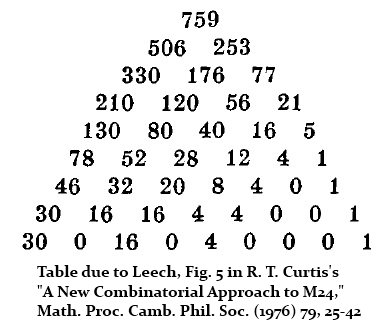
For graphic block designs, I prefer the blocks (and the parents)
of Grand Rapids to those of New York City.
For the barbed tail of Clarke's "Angel" story, see the New Zealand post
of New Year's Day mentioned above.
Monday, December 5, 2011
The Shining (Norwegian Version)
A check tonight of Norwegian artist Josefine Lyche's recent activities
shows she has added a video to her web page that has for some time
contained a wall piece based on the 2×2 case of the diamond theorem —
The video (top left in screenshot above) is a tasteless New-Age discourse
that sounds frighteningly like the teachings of the late Heaven's Gate cult.
Investigating the source of the video on vimeo.com, I found the account of one "Jo Lyxe,"
who joined vimeo in September 2011. This is apparently a variant of Josefine Lyche's name.
The account has three videos—
- "High on RAM (OverLoad)"– Fluid running through a computer's innards
- "Death 2 Everyone"– A mystic vision of the afterlife
- "Realization of the Ultimate Reality (Beyond Form)"– The Blue Star video above
Lyche has elsewhere discussed her New-Age interests, so the contents of the videos
were not too surprising… except for one thing. Vimeo.com states that all three videos
were uploaded "2 months ago"— apparently when "Lyxe" first set up an account.*
I do not know, or particularly care, where she got the Blue Star video, but the other
videos interested me considerably when I found them tonight… since they are
drawn from films I discussed in this journal much more recently than "2 months ago."
"High on RAM (OverLoad)" is taken from the 1984 film "Electric Dreams" that I came across
and discussed here yesterday afternoon, well before re-encountering it again tonight.
And "Death 2 Everyone" (whose title** is perhaps a philosophical statement about inevitable mortality
rather than a mad terrorist curse) is taken from the 1983 Natalie Wood film "Brainstorm."
"Brainstorm" was also discussed here recently… on November 18th, in a post suggested by the
reopening of the investigation into Wood's death.
I had no inkling that these "Jo Lyxe" videos existed until tonight.
The overlapping content of Lyche's mental ramblings and my own seems rather surprising.
Perhaps it is a Norwegian mind-meld, perhaps just a coincidence of interests.
* Update: Google searches by the titles on Dec. 5 show that all three "Lyxe" videos
were uploaded on September 20 and 21, 2011.
** Update: A search shows a track with this title on a Glasgow band's 1994 album.
Friday, September 16, 2011
Icons
Background: Jung's Aion in this journal discusses this
figure from finite geometry's diamond theorem—
![]()
Fig. A
This resembles a figure that served Jung
as a schema of the Self—
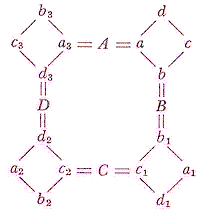
Fig. B
Fig. A, with color variations, serves as the core
of many automatically generated Identicons —
a different sort of self-symbol.
Examples from Sept. 6 at MathOverflow—
![]()
![]()
A user wanting to custom-tailor his self-symbol should consider
the following from the identicon service Gravatar—
1. User Submissions. "… you hereby do and shall grant to Automattic a worldwide, perpetual, irrevocable, royalty-free and fully-paid, transferable (including rights to sublicense) right to perform the Services (e.g., to use, modify, reproduce, distribute, prepare derivative works of, display, perform, and otherwise fully exercise and exploit all intellectual property, publicity, and moral rights with respect to any User Submissions, and to allow others to do so)."
Sounds rather Faustian.
Saturday, August 6, 2011
Norway Summer
(Continued from June 21)
Footnote to a new web page from the European Culture Congress—
Photo credit: Josefine Lyche, “The 2×2 Case (Diamond Theorem)
after Steven H. Cullinane”, 450 x 650 cm,
Tromsø Kunstforening, 2010, image courtesy: the artist.
Thursday, August 4, 2011
Midnight in Oslo
For Norway's Niels Henrik Abel (1802-1829)
on his birthday, August Fifth
(6 PM Aug. 4, Eastern Time, is 12 AM Aug. 5 in Oslo.)
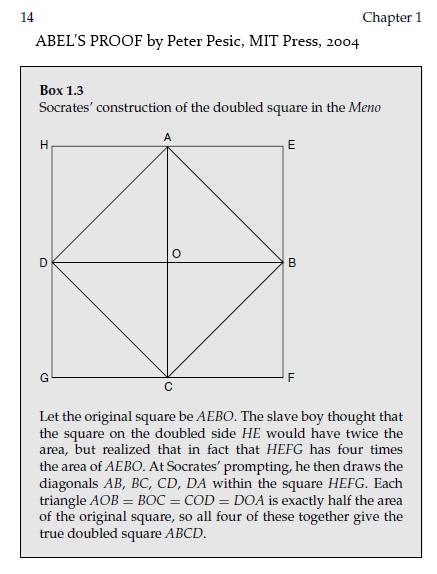
Plato's Diamond
The above version by Peter Pesic is from Chapter I of his book Abel's Proof , titled "The Scandal of the Irrational." Plato's diamond also occurs in a much later mathematical story that might be called "The Scandal of the Noncontinuous." The story—
Paradigms"These passages suggest that the Form is a character or set of characters common to a number of things, i.e. the feature in reality which corresponds to a general word. But Plato also uses language which suggests not only that the forms exist separately (χωριστά ) from all the particulars, but also that each form is a peculiarly accurate or good particular of its own kind, i.e. the standard particular of the kind in question or the model (παράδειγμα ) [i.e. paradigm ] to which other particulars approximate…. … Both in the Republic and in the Sophist there is a strong suggestion that correct thinking is following out the connexions between Forms. The model is mathematical thinking, e.g. the proof given in the Meno that the square on the diagonal is double the original square in area." – William and Martha Kneale, The Development of Logic , Oxford University Press paperback, 1985 Plato's paradigm in the Meno—
Changed paradigm in the diamond theorem (2×2 case) —
Aspects of the paradigm change— Monochrome figures to Areas to Continuous transformations to Euclidean geometry to Euclidean quantities to The 24 patterns resulting from the paradigm change—
Each pattern has some ordinary or color-interchange symmetry. This is the 2×2 case of a more general result. The patterns become more interesting in the 4×4 case. For their relationship to finite geometry and finite fields, see the diamond theorem. |
Related material: Plato's Diamond by Oslo artist Josefine Lyche.
“Plato’s Ghost evokes Yeats’s lament that any claim to worldly perfection inevitably is proven wrong by the philosopher’s ghost….”
— Princeton University Press on Plato’s Ghost: The Modernist Transformation of Mathematics (by Jeremy Gray, September 2008)
"Remember me to her."
— Closing words of the Algis Budrys novel Rogue Moon .
Background— Some posts in this journal related to Abel or to random thoughts from his birthday.
Friday, July 1, 2011
Symmetry Review
Popular novelist Dan Brown is to speak at Chautauqua Institution on August 1.
This suggests a review of some figures discussed here in a note on Brown from February 20, 2004—

Related material: Notes from Nov. 5, 1981, and from Dec. 24, 1981.
For the lower figure in context, see the diamond theorem.
Wednesday, June 1, 2011
The Schwartz Notes
A Google search today for material on the Web that puts the diamond theorem
in context yielded a satisfyingly complete list. (See the first 21 results.)
(Customization based on signed-out search activity was disabled.)
The same search limited to results from only the past month yielded,
in addition, the following—
This turns out to be a document by one Richard Evan Schwartz,
Chancellor’s Professor of Mathematics at Brown University.
Pages 12-14 of the document, which is untitled, undated, and
unsigned, discuss the finite-geometry background of the R.T.
Curtis Miracle Octad Generator (MOG) . As today’s earlier search indicates,
this is closely related to the diamond theorem. The section relating
the geometry to the MOG is titled “The MOG and Projective Space.”
It does not mention my own work.
See Schwartz’s page 12, page 13, and page 14.
Compare to the web pages from today’s earlier search.
There are no references at the end of the Schwartz document,
but there is this at the beginning—
These are some notes on error correcting codes. Two good sources for
this material are
• From Error Correcting Codes through Sphere Packings to Simple Groups ,
by Thomas Thompson.
• Sphere Packings, Lattices, and Simple Groups by J. H. Conway and N.
Sloane
Planet Math (on the internet) also some information.
It seems clear that these inadequate remarks by Schwartz on his sources
can and should be expanded.
Tuesday, May 10, 2011
Groups Acting
The LA Times on last weekend's film "Thor"—
"… the film… attempts to bridge director Kenneth Branagh's high-minded Shakespearean intentions with Marvel Entertainment's bottom-line-oriented need to crank out entertainment product."
Those averse to Nordic religion may contemplate a different approach to entertainment (such as Taymor's recent approach to Spider-Man).
A high-minded— if not Shakespearean— non-Nordic approach to groups acting—
"What was wrong? I had taken almost four semesters of algebra in college. I had read every page of Herstein, tried every exercise. Somehow, a message had been lost on me. Groups act . The elements of a group do not have to just sit there, abstract and implacable; they can do things, they can 'produce changes.' In particular, groups arise naturally as the symmetries of a set with structure. And if a group is given abstractly, such as the fundamental group of a simplical complex or a presentation in terms of generators and relators, then it might be a good idea to find something for the group to act on, such as the universal covering space or a graph."
— Thomas W. Tucker, review of Lyndon's Groups and Geometry in The American Mathematical Monthly , Vol. 94, No. 4 (April 1987), pp. 392-394
"Groups act "… For some examples, see
- The 2×2×2 Cube,
- The Diamond 16 Puzzle,
- The Diamond Theorem, and
- Finite Geometry of the Square and Cube.
Related entertainment—
High-minded— Many Dimensions—

Not so high-minded— The Cosmic Cube—

One way of blending high and low—
The high-minded Charles Williams tells a story
in his novel Many Dimensions about a cosmically
significant cube inscribed with the Tetragrammaton—
the name, in Hebrew, of God.
The following figure can be interpreted as
the Hebrew letter Aleph inscribed in a 3×3 square—
The above illustration is from undated software by Ed Pegg Jr.
For mathematical background, see a 1985 note, "Visualizing GL(2,p)."
For entertainment purposes, that note can be generalized from square to cube
(as Pegg does with his "GL(3,3)" software button).
For the Nordic-averse, some background on the Hebrew connection—
Friday, May 6, 2011
Theme and Variations
— Richard Powers, "The Perpetual Calendar," from The Gold Bug Variations , 1991
See also, from last All Hallows' Eve, "Diamond Theorem in Norway."
Tuesday, April 26, 2011
25 Years Ago Today
The above points and hyperplanes underlie the symmetries discussed
in the diamond theorem. See The Oslo Version and related remarks
for a different use in art.
Friday, March 18, 2011
Defining Configurations*
The On-Line Encyclopedia of Integer Sequences has an article titled "Number of combinatorial configurations of type (n_3)," by N.J.A. Sloane and D. Glynn.
From that article:
- DEFINITION: A combinatorial configuration of type (n_3) consists of an (abstract) set of n points together with a set of n triples of points, called lines, such that each point belongs to 3 lines and each line contains 3 points.
- EXAMPLE: The unique (8_3) configuration consists of the triples 125, 148, 167, 236, 278, 347, 358, 456.
The following corrects the word "unique" in the example.

* This post corrects an earlier post, also numbered 14660 and dated 7 PM March 18, 2011, that was in error.
The correction was made at about 11:50 AM on March 20, 2011.
_____________________________________________________________
Update of March 21
The problem here is of course with the definition. Sloane and Glynn failed to include in their definition a condition that is common in other definitions of configurations, even abstract or purely "combinatorial" configurations. See, for instance, Configurations of Points and Lines , by Branko Grunbaum (American Mathematical Society, 2009), p. 17—
In the most general sense we shall consider combinatorial (or abstract) configurations; we shall use the term set-configurations as well. In this setting "points" are interpreted as any symbols (usually letters or integers), and "lines" are families of such symbols; "incidence" means that a "point" is an element of a "line". It follows that combinatorial configurations are special kinds of general incidence structures. Occasionally, in order to simplify and clarify the language, for "points" we shall use the term marks, and for "lines" we shall use blocks. The main property of geometric configurations that is preserved in the generalization to set-configurations (and that characterizes such configurations) is that two marks are incident with at most one block, and two blocks with at most one mark.
Whether or not omitting this "at most one" condition from the definition is aesthetically the best choice, it dramatically changes the number of configurations in the resulting theory, as the above (8_3) examples show.
Update of March 22 (itself updated on March 25)
For further background on configurations, see Dolgachev—

Note that the two examples Dolgachev mentions here, with 16 points and 9 points, are not unrelated to the geometry of 4×4 and 3×3 square arrays. For the Kummer and related 16-point configurations, see section 10.3, "The Three Biplanes of Order 4," in Burkard Polster's A Geometrical Picture Book (Springer, 1998). See also the 4×4 array described by Gordon Royle in an undated web page and in 1980 by Assmus and Sardi. For the Hesse configuration, see (for instance) the passage from Coxeter quoted in Quaternions in an Affine Galois Plane.
Update of March 27
See the above link to the (16,6) 4×4 array and the (16,6) exercises using this array in R.D. Carmichael's classic Introduction to the Theory of Groups of Finite Order (1937), pp. 42-43. For a connection of this sort of 4×4 geometry to the geometry of the diamond theorem, read "The 2-subsets of a 6-set are the points of a PG(3,2)" (a note from 1986) in light of R.W.H.T. Hudson's 1905 classic Kummer's Quartic Surface , pages 8-9, 16-17, 44-45, 76-77, 78-79, and 80.
Sunday, March 13, 2011
The Counter
"…as we saw, there are two different Latin squares of order 4…."
— Peter J. Cameron, "The Shrikhande Graph," August 26, 2010
Cameron counts Latin squares as the same if they are isotopic .
Some further context for Cameron's remark—
Cover Illustration Number 1 (1976):
Cover Illustration Number 2 (1991):
The Shrikhande Graph
______________________________________________________________________________
This post was prompted by two remarks…
1. In a different weblog, also on August 26, 2010—
The Accidental Mathematician— "The Girl Who Played with Fermat's Theorem."
"The worst thing about the series is the mathematical interludes in The Girl Who Played With Fire….
Salander is fascinated by a theorem on perfect numbers—
one can verify it for as many numbers as one wishes, and it never fails!—
and then advances through 'Archimedes, Newton, Martin Gardner,*
and a dozen other classical mathematicians,' all the way to Fermat’s last theorem."
2. "The fact that the pattern retains its symmetry when you permute the rows and columns
is very well known to combinatorial theorists who work with matrices."
[My italics; note resemblance to the Brualdi-Ryser title above.]
–Martin Gardner in 1976 on the diamond theorem
* Compare Eric Temple Bell (as quoted at the MacTutor history of mathematics site)—
"Archimedes, Newton, and Gauss, these three, are in a class by themselves
among the great mathematicians, and it is not for ordinary mortals
to attempt to range them in order of merit."
This is from the chapter on Gauss in Men of Mathematics .
Friday, March 4, 2011
Oh, When the Saints…
In memory of John Miner —
|
See also |
AMS logo—Note resemblance Click on pictures for details. |
This morning's LA Times —
Related remarks —
-
"I’ve heard of affairs that are strictly plutonic,
But diamonds are a girl’s best friend!" -
"In this talk, we will prove the diamond theorem and explore symmetries…."
– Log24 on the date of John Miner's death
Thursday, February 17, 2011
Paradigms
"These passages suggest that the Form is a character or set of characters
common to a number of things, i.e. the feature in reality which corresponds
to a general word. But Plato also uses language which suggests not only
that the forms exist separately (χωριστά ) from all the particulars, but also
that each form is a peculiarly accurate or good particular of its own kind,
i.e. the standard particular of the kind in question or the model (παράδειγμα )
[i.e. paradigm ] to which other particulars approximate….
… Both in the Republic and in the Sophist there is a strong suggestion
that correct thinking is following out the connexions between Forms.
The model is mathematical thinking, e.g. the proof given in the Meno
that the square on the diagonal is double the original square in area."
— William and Martha Kneale, The Development of Logic,
Oxford University Press paperback, 1985
Plato's paradigm in the Meno —

Changed paradigm in the diamond theorem (2×2 case) —

Aspects of the paradigm change* —
Monochrome figures to
colored figures
Areas to
transformations
Continuous transformations to
non-continuous transformations
Euclidean geometry to
finite geometry
Euclidean quantities to
finite fields
Some pedagogues may find handling all of these
conceptual changes simultaneously somewhat difficult.
* "Paradigm shift " is a phrase that, as John Baez has rightly pointed out,
should be used with caution. The related phrase here was suggested by Plato's
term παράδειγμα above, along with the commentators' specific reference to
the Meno figure that serves as a model. (For "model" in a different sense,
see Burkard Polster.) But note that Baez's own beloved category theory
has been called a paradigm shift.
Wednesday, December 29, 2010
True Grid
Part I: True
Bulletin of the American Mathematical Society , October 2002, page 563 —
“… the study of symmetries of patterns led to… finite geometries….”
– David W. Henderson, Cornell University
This statement may be misleading, if not (see Part II below) actually false. In truth, finite geometries appear to have first arisen from Fano's research on axiom systems. See The Axioms of Projective Geometry by Alfred North Whitehead, Cambridge University Press, 1906, page 13.
Part II: Grid
For the story of how symmetries of patterns later did lead to finite geometries, see the diamond theorem.
Wednesday, December 15, 2010
Punch
David Corfield discusses the philosophy of mathematics (Dec. 14) —
"It’s very tricky choosing a rich and interesting case study which is philosophically salient. To encourage the reader or listener to follow up the mathematics to understand what you’re saying, there must be a decent pay-off. An intricate twentieth century case study had better pack plenty of meta-mathematical punch."
Steve Martin discusses the philosophy of art (Dec. 5) —
 |
 |
CBS News interviews Martin at the Whitney Museum —
"We paused to consider the impact of a George Bellows fight scene. Martin said it has 'wall power.'
What does that phrase mean? 'How it holds the wall. How it feels when you're ten or 20 feet away from it. It really takes hold of the room.'"
See also Halloween 2010 —
Saturday, November 27, 2010
Simplex Sigillum Veri
An Adamantine View of "The [Philosophers'] Stone"
The New York Times column "The Stone" on Sunday, Nov. 21 had this—
"Wittgenstein was formally presenting his Tractatus Logico-Philosophicus , an already well-known work he had written in 1921, as his doctoral thesis. Russell and Moore were respectfully suggesting that they didn’t quite understand proposition 5.4541 when they were abruptly cut off by the irritable Wittgenstein. 'I don’t expect you to understand!' (I am relying on local legend here….)"
Proposition 5.4541*—
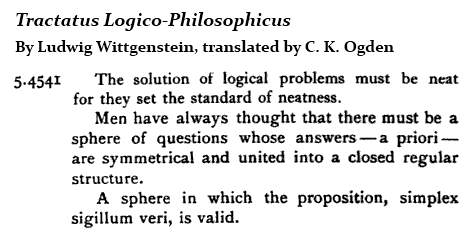
Related material, found during a further search—
A commentary on "simplex sigillum veri" leads to the phrase "adamantine crystalline structure of logic"—

For related metaphors, see The Diamond Cube, Design Cube 2x2x2, and A Simple Reflection Group of Order 168.
Here Łukasiewicz's phrase "the hardest of materials" apparently suggested the commentators' adjective "adamantine." The word "diamond" in the links above refers of course not to a material, but to a geometric form, the equiangular rhombus. For a connection of this sort of geometry with logic, see The Diamond Theorem and The Geometry of Logic.
For more about God, a Stone, logic, and cubes, see Tale (Nov. 23).
* 5.4541 in the German original—
Die Lösungen der logischen Probleme müssen einfach sein,
denn sie setzen den Standard der Einfachheit.
Die Menschen haben immer geahnt, dass es
ein Gebiet von Fragen geben müsse, deren Antworten—
a priori—symmetrisch, und zu einem abgeschlossenen,
regelmäßigen Gebilde vereint liegen.
Ein Gebiet, in dem der Satz gilt: simplex sigillum veri.
Here "einfach" means "simple," not "neat," and "Gebiet" means
"area, region, field, realm," not (except metaphorically) "sphere."
Tuesday, November 2, 2010
A Dozen Pairs of Opposites —
24 graphic patterns arranged in space
as 12 pairs of opposites
Click image for an illustration of how the above labeling was derived.
For further background, see Cases of the Diamond Theorem
and recent art by Josefine Lyche of Norway.
Saturday, July 3, 2010
Beyond the Limits
"Human perception is a saga of created reality. But we were devising entities beyond the agreed-upon limits of recognition or interpretation…."
– Don DeLillo, Point Omega
Capitalized, the letter omega figures in the theology of two Jesuits, Teilhard de Chardin and Gerard Manley Hopkins. For the former, see a review of DeLillo. For the latter, see James Finn Cotter's Inscape and "Hopkins and Augustine."
The lower-case omega is found in the standard symbolic representation of the Galois field GF(4)—
A representation of GF(4) that goes beyond the standard representation—
Here the four diagonally-divided two-color squares represent the four elements of GF(4).
The graphic properties of these design elements are closely related to the algebraic properties of GF(4).
This is demonstrated by a decomposition theorem used in the proof of the diamond theorem.
To what extent these theorems are part of "a saga of created reality" may be debated.
I prefer the Platonist's "discovered, not created" side of the debate.
Saturday, June 19, 2010
Imago Creationis
In the above view, four of the tesseract's 16
vertices are overlaid by other vertices.
For views that are more complete and
moveable, see Smith's tesseract page.
Four-Part Tesseract Divisions—

The above figure shows how four-part partitions
of the 16 vertices of a tesseract in an infinite
Euclidean space are related to four-part partitions
of the 16 points in a finite Galois space
|
Euclidean spaces versus Galois spaces in a larger context—
Infinite versus Finite The central aim of Western religion —
"Each of us has something to offer the Creator...
the bridging of
masculine and feminine,
life and death.
It's redemption.... nothing else matters."
-- Martha Cooley in The Archivist (1998)
The central aim of Western philosophy —
Dualities of Pythagoras
as reconstructed by Aristotle:
Limited Unlimited
Odd Even
Male Female
Light Dark
Straight Curved
... and so on ....
"Of these dualities, the first is the most important; all the others may be seen as different aspects of this fundamental dichotomy. To establish a rational and consistent relationship between the limited [man, etc.] and the unlimited [the cosmos, etc.] is… the central aim of all Western philosophy." |
Another picture related to philosophy and religion—
Jung's Four-Diamond Figure from Aion—

This figure was devised by Jung
to represent the Self. Compare the
remarks of Paul Valéry on the Self—
|
Flight from Eden: The Origins of Modern Literary Criticism and Theory, by Steven Cassedy, U. of California Press, 1990, pages 156-157—
Valéry saw the mind as essentially a relational system whose operation he attempted to describe in the language of group mathematics. "Every act of understanding is based on a group," he says (C, 1:331). "My specialty— reducing everything to the study of a system closed on itself and finite" (C, 19: 645). The transformation model came into play, too. At each moment of mental life the mind is like a group, or relational system, but since mental life is continuous over time, one "group" undergoes a "transformation" and becomes a different group in the next moment. If the mind is constantly being transformed, how do we account for the continuity of the self? Simple; by invoking the notion of the invariant. And so we find passages like this one: "The S[elf] is invariant, origin, locus or field, it's a functional property of consciousness" (C, 15:170 [2:315]). Just as in transformational geometry, something remains fixed in all the projective transformations of the mind's momentary systems, and that something is the Self (le Moi, or just M, as Valéry notates it so that it will look like an algebraic variable). Transformation theory is all over the place. "Mathematical science… reduced to algebra, that is, to the analysis of the transformations of a purely differential being made up of homogeneous elements, is the most faithful document of the properties of grouping, disjunction, and variation in the mind" (O, 1:36). "Psychology is a theory of transformations, we just need to isolate the invariants and the groups" (C, 1:915). "Man is a system that transforms itself" (C, 2:896). O Paul Valéry, Oeuvres (Paris: Pléiade, 1957-60) C Valéry, Cahiers, 29 vols. (Paris: Centre National de le Recherche Scientifique, 1957-61) |
Note also the remarks of George David Birkhoff at Rice University
in 1940 (pdf) on Galois's theory of groups and the related
"theory of ambiguity" in Galois's testamentary letter—
|
… metaphysical reasoning always relies on the Principle of Sufficient Reason, and… the true meaning of this Principle is to be found in the “Theory of Ambiguity” and in the associated mathematical “Theory of Groups.” If I were a Leibnizian mystic, believing in his “preestablished harmony,” and the “best possible world” so satirized by Voltaire in “Candide,” I would say that the metaphysical importance of the Principle of Sufficient Reason and the cognate Theory of Groups arises from the fact that God thinks multi-dimensionally* whereas men can only think in linear syllogistic series, and the Theory of Groups is the appropriate instrument of thought to remedy our deficiency in this respect. * That is, uses multi-dimensional symbols beyond our grasp. |
Related material:
A medal designed by Leibniz to show how
binary arithmetic mirrors the creation by God
of something (1) from nothing (0).

Another array of 16 strings of 0's and 1's, this time
regarded as coordinates rather than binary numbers—


Some context by a British mathematician —

|
Imago by Wallace Stevens Who can pick up the weight of Britain, Who can move the German load Or say to the French here is France again? Imago. Imago. Imago. It is nothing, no great thing, nor man Of ten brilliancies of battered gold And fortunate stone. It moves its parade Of motions in the mind and heart, A gorgeous fortitude. Medium man In February hears the imagination's hymns And sees its images, its motions And multitudes of motions And feels the imagination's mercies, In a season more than sun and south wind, Something returning from a deeper quarter, A glacier running through delirium, Making this heavy rock a place, Which is not of our lives composed . . . Lightly and lightly, O my land, Move lightly through the air again. |
Tuesday, June 15, 2010
Imago, Imago, Imago
Recommended— an online book—
Flight from Eden: The Origins of Modern Literary Criticism and Theory,
by Steven Cassedy, U. of California Press, 1990.
See in particular
Valéry and the Discourse On His Method.
Pages 156-157—
Valéry saw the mind as essentially a relational system whose operation he attempted to describe in the language of group mathematics. “Every act of understanding is based on a group,” he says (C, 1:331). “My specialty—reducing everything to the study of a system closed on itself and finite” (C, 19: 645). The transformation model came into play, too. At each moment of mental life the mind is like a group, or relational system, but since mental life is continuous over time, one “group” undergoes a “transformation” and becomes a different group in the next moment. If the mind is constantly being transformed, how do we account for the continuity of the self? Simple; by invoking the notion of the invariant. And so we find passages like this one: “The S[elf] is invariant, origin, locus or field, it’s a functional property of consciousness” (C, 15:170 [2: 315]). Just as in transformational geometry, something remains fixed in all the projective transformations of the mind’s momentary systems, and that something is the Self (le Moi, or just M, as Valéry notates it so that it will look like an algebraic variable). Transformation theory is all over the place. “Mathematical science . . . reduced to algebra, that is, to the analysis of the transformations of a purely differential being made up of homogeneous elements, is the most faithful document of the properties of grouping, disjunction, and variation in the mind” (O, 1:36). “Psychology is a theory of transformations, we just need to isolate the invariants and the groups” (C, 1:915). “Man is a system that transforms itself” (C, 2:896).
O Paul Valéry, Oeuvres (Paris: Pléiade, 1957-60)
C Valéry, Cahiers, 29 vols. (Paris: Centre National de le Recherche Scientifique, 1957-61)
Compare Jung’s image in Aion of the Self as a four-diamond figure:

and Cullinane’s purely geometric four-diamond figure:

For a natural group of 322,560 transformations acting on the latter figure, see the diamond theorem.
What remains fixed (globally, not pointwise) under these transformations is the system of points and hyperplanes from the diamond theorem. This system was depicted by artist Josefine Lyche in her installation “Theme and Variations” in Oslo in 2009. Lyche titled this part of her installation “The Smallest Perfect Universe,” a phrase used earlier by Burkard Polster to describe the projective 3-space PG(3,2) that contains these points (at right below) and hyperplanes (at left below).
Although the system of points (at right above) and hyperplanes (at left above) exemplifies Valéry’s notion of invariant, it seems unlikely to be the sort of thing he had in mind as an image of the Self.
Monday, June 7, 2010
Inspirational Combinatorics
According to the Mathematical Association of America this morning, one purpose of the upcoming June/July issue of the Notices of the American Mathematical Society is
"…to stress the inspirational role of combinatorics…."
Here is another contribution along those lines—
Eidetic Variation
from page 244 of
From Combinatorics to Philosophy: The Legacy of G.-C. Rota,
hardcover, published by Springer on August 4, 2009
(Edited by Ernesto Damiani, Ottavio D'Antona, Vincenzo Marra, and Fabrizio Palombi)
"Rota's Philosophical Insights," by Massimo Mugnai—
"… In other words, 'objectivism' is the attitude [that tries] to render a particular aspect absolute and dominant over the others; it is a kind of narrow-mindedness attempting to reduce to only one the multiple layers which constitute what we call 'reality.' According to Rota, this narrow-mindedness limits in an essential way even of [sic ] the most basic facts of our cognitive activity, as, for example, the understanding of a simple declarative sentence: 'So objectivism is the error we [make when we] persist in believing that we can understand what a declarative sentence means without a possible thematization of this declarative sentence in one of [an] endless variety of possible contexts' (Rota, 1991*, p. 155). Rota here implicitly refers to what, amongst phenomenologists is known as eidetic variation, i.e. the change of perspective, imposed by experience or performed voluntarily, from which to look at things, facts or sentences of the world. A typical example, proposed by Heidegger, in Sein und Zeit (1927) and repeated many times by Rota, is that of the hammer."
* Rota, G.-C. (1991), The End of Objectivity: The Legacy of Phenomenology. Lectures at MIT, Cambridge, MA, MIT Mathematics Department
The example of the hammer appears also on yesterday's online New York Times front page—

Related material:
From The Blackwell Dictionary of Western Philosophy—
Eidetic variation — an alternative expression for eidetic reduction
Husserl's term for an intuitive act toward an essence or universal, in contrast to an empirical intuition or perception. He also called this act an essential intuition, eidetic intuition, or eidetic variation. In Greek, eideo means “to see” and what is seen is an eidos (Platonic Form), that is, the common characteristic of a number of entities or regularities in experience. For Plato, eidos means what is seen by the eye of the soul and is identical with essence. Husserl also called this act “ideation,” for ideo is synonymous with eideo and also means “to see” in Greek. Correspondingly, idea is identical to eidos.
An example of eidos— Plato's diamond (from the Meno )—

For examples of variation of this eidos, see the diamond theorem.
See also Blockheads (8/22/08).
Related poetic remarks— The Trials of Device.
Sunday, May 23, 2010
For Your Consideration —
Cannes Festival Readies for Awards Night
Uncertified Copy
The pictures in the detail are copies of
figures created by S. H. Cullinane in 1986.
They illustrate his model of hyperplanes
and points in the finite projective space
known as PG(3,2) that underlies
Cullinane's diamond theorem.
The title of the pictures in the detail
is that of a film by Burkard Polster
that portrays a rival model of PG(3,2).
The artist credits neither Cullinane nor Polster.
Saturday, January 30, 2010
Metamorphosis and Metaphor
"Animation tends to be a condensed art form, using metamorphosis and metaphor to collide and expand meaning. In this way it resembles poetry."
— Harvard's Carpenter Center for the Visual Arts,
description of an exhibition–
FRAME BY FRAME: ANIMATED AT HARVARD
January 28–Feb 14, 2010
For example–
Animation — The Animated Diamond Theorem,
now shown frame by frame for selected frames
Poetry–
Part I — "That Nature is a Heraclitean Fire…."
Part II — Metaphor on the covers of a Salinger book–
For other thoughts on
metamorphosis and metaphor,
see Endgame.
Saturday, December 26, 2009
Annals of Philosophy
Towards a Philosophy of Real Mathematics, by David Corfield, Cambridge U. Press, 2003, p. 206:
"Now, it is no easy business defining what one means by the term conceptual…. I think we can say that the conceptual is usually expressible in terms of broad principles. A nice example of this comes in the form of harmonic analysis, which is based on the idea, whose scope has been shown by George Mackey (1992) to be immense, that many kinds of entity become easier to handle by decomposing them into components belonging to spaces invariant under specified symmetries."
For a simpler example of this idea, see the entities in The Diamond Theorem, the decomposition in A Four-Color Theorem, and the space in Geometry of the 4×4 Square. The decomposition differs from that of harmonic analysis, although the subspaces involved in the diamond theorem are isomorphic to Walsh functions— well-known as discrete analogues of the trigonometric functions of traditional harmonic analysis.
Saturday, December 5, 2009
Holiday Book
Time and Chance, continued…
NY Lottery numbers today–
Midday 401, Evening 717
_________________________________________________
From this journal on 4/01, 2009:
The Cruelest Month

"Langdon sensed she was
toying with him…."
___________________________________________
From this journal on 7/17, 2008:
Jung’s four-diamond figure from
Aion — a symbol of the self –

Jung’s Map of the Soul,
by Murray Stein:
“… Jung thinks of the self as undergoing continual transformation during the course of a lifetime…. At the end of his late work Aion, Jung presents a diagram to illustrate the dynamic movements of the self….”
For related dynamic movements,
see the Diamond 16 Puzzle
and the diamond theorem.
Monday, July 20, 2009
Monday July 20, 2009
in this weblog:
What NASA needs now is the power of the Word. On Darwin’s tongue, the Word created a revolutionary and now well-nigh universal conception of the nature of human beings, or, rather, human beasts. On Freud’s tongue, the Word means that at this very moment there are probably several million orgasms occurring that would not have occurred had Freud never lived. Even the fact that he is proved to be a quack has not diminished the power of his Word.
July 20, 1969, was the moment NASA needed, more than anything else in this world, the Word. But that was something NASA’s engineers had no specifications for. At this moment, that remains the only solution to recovering NASA’s true destiny, which is, of course, to build that bridge to the stars.
Tom Wolfe is the author of “The Right Stuff,” an account of the Mercury Seven astronauts.
Commentary
Tuesday, March 17, 2009
Tuesday March 17, 2009

The Square of Oppositon
at Stanford Encylopedia of Philosophy

The Square of Opposition
in its original form
"The diagram above is from a ninth century manuscript of Apuleius' commentary on Aristotle's Perihermaneias, probably one of the oldest surviving pictures of the square."
— Edward Buckner at The Logic Museum
From the webpage "Semiotics for Beginners: Paradigmatic Analysis," by Daniel Chandler:

The Semiotic Square
"The structuralist semiotician Algirdas Greimas introduced the semiotic square (which he adapted from the 'logical square' of scholastic philosophy) as a means of analysing paired concepts more fully (Greimas 1987,* xiv, 49). The semiotic square is intended to map the logical conjunctions and disjunctions relating key semantic features in a text. Fredric Jameson notes that 'the entire mechanism… is capable of generating at least ten conceivable positions out of a rudimentary binary opposition' (in Greimas 1987,* xiv). Whilst this suggests that the possibilities for signification in a semiotic system are richer than the either/or of binary logic, but that [sic] they are nevertheless subject to 'semiotic constraints' – 'deep structures' providing basic axes of signification."
* Greimas, Algirdas (1987): On Meaning: Selected Writings in Semiotic Theory (trans. Paul J Perron & Frank H Collins). London: Frances Pinter
Another version of the semiotic square:

Here is a more explicit figure representing the Klein group:
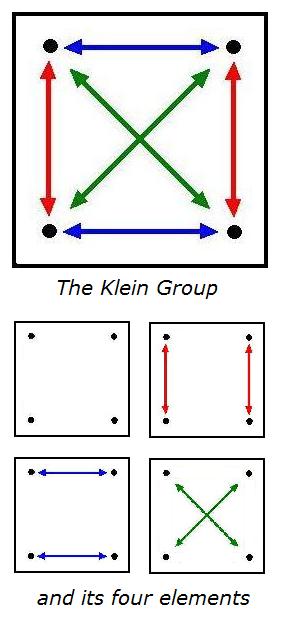
There is also the logical
diamond of opposition —

A semiotic (as opposed to logical)
diamond has been used to illustrate
remarks by Fredric Jameson,
a Marxist literary theorist:
|
"Introduction to Algirdas Greimas, Module on the Semiotic Square," by Dino Felluga at Purdue University–
The semiotic square has proven to be an influential concept not only in narrative theory but in the ideological criticism of Fredric Jameson, who uses the square as "a virtual map of conceptual closure, or better still, of the closure of ideology itself" ("Foreword"* xv). (For more on Jameson, see the [Purdue University] Jameson module on ideology.) Greimas' schema is useful since it illustrates the full complexity of any given semantic term (seme). Greimas points out that any given seme entails its opposite or "contrary." "Life" (s1) for example is understood in relation to its contrary, "death" (s2). Rather than rest at this simple binary opposition (S), however, Greimas points out that the opposition, "life" and "death," suggests what Greimas terms a contradictory pair (-S), i.e., "not-life" (-s1) and "not-death" (-s2). We would therefore be left with the following semiotic square (Fig. 1): 
As Jameson explains in the Foreword to Greimas' On Meaning, "-s1 and -s2"—which in this example are taken up by "not-death" and "not-life"—"are the simple negatives of the two dominant terms, but include far more than either: thus 'nonwhite' includes more than 'black,' 'nonmale' more than 'female'" (xiv); in our example, not-life would include more than merely death and not-death more than life.
* Jameson, Fredric. "Foreword." On Meaning: Selected Writings in Semiotic Theory. By Algirdas Greimas. Trans. Paul J. Perron and Frank H. Collins. Minneapolis: U of Minnesota P, 1976.
|
— The Gameplayers of Zan, by M.A. Foster
"For every kind of vampire,
there is a kind of cross."
— Thomas Pynchon,
Gravity's Rainbow
Crosses used by semioticians
to baffle their opponents
are illustrated above.
Some other kinds of crosses,
and another kind of opponent:
|
Monday, July 11, 2005
Logos
for St. Benedict's Day Click on either of the logos below for religious meditations– on the left, a Jewish meditation from the Conference of Catholic Bishops; on the right, an Aryan meditation from Stormfront.org. Both logos represent different embodiments of the "story theory" of truth, as opposed to the "diamond theory" of truth. Both logos claim, in their own ways, to represent the eternal Logos of the Christian religion. I personally prefer the "diamond theory" of truth, represented by the logo below.
See also the previous entry Sunday, July 10, 2005
Mathematics
and Narrative Click on the title for a narrative about
Nikolaos K. Artemiadis,

"First of all, I'd like to
— Remark attributed to Plato
|
||||||||
Wednesday, March 11, 2009
Wednesday March 11, 2009
in Translation
(continued from
May 15, 1998)
The New York Times March 10–
"Paris | A Show About Nothing"–

The Times describes one of the empty rooms on exhibit as…
"… Yves Klein’s 'La spécialisation de la sensibilité à l’état matière première en sensibilité picturale stabilisée, Le Vide' ('The Specialization of Sensibility in the Raw Material State Into Stabilized Pictorial Sensibility, the Void')"
This is a mistranslation. See "An Aesthetics of Matter" (pdf), by Kiyohiko Kitamura and Tomoyuki Kitamura, pp. 85-101 in International Yearbook of Aesthetics, Volume 6, 2002—
"The exhibition «La spécialisation de la sensibilité à l’état matière-première en sensibilité picturale stabilisée», better known as «Le Vide» (The Void) was held at the Gallery Iris Clert in Paris from April 28th till May 5th, 1955." –p. 94
"… «Sensibility in the state of prime matter»… filled the emptiness." –p. 95
Kitamura and Kitamura translate matière première correctly as "prime matter" (the prima materia of the scholastic philosophers) rather than "raw material." (The phrase in French can mean either.)
The Diamond Archetype and
The Illuminati Diamond.
The link above to
prima materia
is to an 1876 review
by Cardinal Manning of
a work on philosophy
by T. P. Kirkman, whose
"schoolgirl problem" is
closely related to the
finite space of the
diamond theorem.
Monday, March 9, 2009
Monday March 9, 2009
Humorism

"Always with a
little humor."
— Dr. Yen Lo

From Temperament: A Brief Survey
For other interpretations
of the above shape, see
The Illuminati Diamond.
from Jung's Aion:
As for rotation, see the ambigrams in Dan Brown's Angels & Demons (to appear as a film May 15) and the following figures:

Click on image
for a related puzzle.
For a solution, see
The Diamond Theorem.
A related note on
"Angels & Demons"
director Ron Howard:

Click image for details.
Thursday, August 14, 2008
Thursday August 14, 2008

(The Glass Bead Game)
is now available for
download in pdf or
text format at Scribd.
Thursday, July 24, 2008
Thursday July 24, 2008
Tried out the new knol.google.com site
with a copy of The Diamond Theorem.
Thursday, July 17, 2008
Thursday July 17, 2008
|
CHANGE FEW CAN BELIEVE IN |
Continued from June 18.
Jungian Symbols
of the Self —

Compare and contrast:
Jung's four-diamond figure from
Aion — a symbol of the self —

Jung's Map of the Soul,
by Murray Stein:
Sunday, April 27, 2008
Sunday April 27, 2008
to the late
Gian-Carlo Rota,
mathematician and
scholar of philosophy
“I believe Husserl to be the greatest philosopher of all times….
Intellectual honesty is the striking quality of Husserl’s writings. He wrote what he honestly believed to be true, neither more nor less. However, honesty is not clarity; as a matter of fact, honesty and clarity are at opposite ends. Husserl proudly refused to stoop to the demands of showmanship that are indispensable in effective communication.”

Related material:
The Diamond Theorem
Monday, March 31, 2008
Monday March 31, 2008
From the geometry page
at cut-the-knot.org:
Related material:
this date three years ago
Wednesday, October 24, 2007
Wednesday October 24, 2007
An earlier entry today (“Hollywood Midrash continued“) on a father and son suggests we might look for an appropriate holy ghost. In that context…

A search for further background on Emmanuel Levinas, a favorite philosopher of the late R. B. Kitaj (previous two entries), led (somewhat indirectly) to the following figures of Descartes:

Compare and contrast:
The harmonic-analysis analogy suggests a review of an earlier entry’s
link today to 4/30– Structure and Logic— as well as
re-examination of Symmetry and a Trinity

(Dec. 4, 2002).
See also —
A Four-Color Theorem,
The Diamond Theorem, and
The Most Violent Poem,

Friday, August 10, 2007
Friday August 10, 2007
The Ring of Gyges
10:31:32 AM ET
Commentary by Richard Wilhelm
on I Ching Hexagram 32:
“Duration is… not a state of rest, for mere standstill is regression.
Duration is rather the self-contained and therefore self-renewing
movement of an organized, firmly integrated whole, taking place in
accordance with immutable laws and beginning anew at every ending.”
Related material
Jung and the Imago Dei
| Log24 on June 10, 2007:
WHAT MAKES IAGO EVIL? some people ask. I never ask. —Joan Didion Iago states that he is not who he is. —Mark F. Frisch |
“Not Being There,”
by Christopher Caldwell,
from next Sunday’s
New York Times Magazine:
| “The chance to try on fresh identities was the great boon that life online was supposed to afford us. Multiuser role-playing games and discussion groups would be venues for living out fantasies. Shielded by anonymity, everyone could now pass a ‘second life’ online as Thor the Motorcycle Sex God or the Sage of Wherever. Some warned, though, that there were other possibilities. The Stanford Internet expert Lawrence Lessig likened online anonymity to the ring of invisibility that surrounds the shepherd Gyges in one of Plato’s dialogues. Under such circumstances, Plato feared, no one is ‘of such an iron nature that he would stand fast in justice.’Time, along with a string of sock-puppet scandals, has proved Lessig and Plato right.” |
“The Boy Who Lived,”
by Christopher Hitchens,
from next Sunday’s
New York Times Book Review:
| On the conclusion of the Harry Potter series:”The toys have been put firmly back in the box, the wand has been folded up, and the conjuror is discreetly accepting payment while the children clamor for fresh entertainments. (I recommend that they graduate to Philip Pullman, whose daemon scheme is finer than any patronus.)” |
I, on the other hand,
recommend Tolkien…
or, for those who are
already familiar with
Tolkien, Plato– to whom
“The Ring of Gyges” may
serve as an introduction.
“It’s all in Plato, all in Plato:
bless me, what do they
teach them at these schools!”
— C. S. Lewis
Saturday, June 2, 2007
Saturday June 2, 2007
“I don’t think the ‘diamond theorem’ is anything serious, so I started with blitzing that.”
— Charles Matthews at Wikipedia, Oct. 2, 2006
“The ‘seriousness’ of a mathematical theorem lies, not in its practical consequences, which are usually negligible, but in the significance of the mathematical ideas which it connects. We may say, roughly, that a mathematical idea is ‘significant’ if it can be connected, in a natural and illuminating way, with a large complex of other mathematical ideas.”
— G. H. Hardy, A Mathematician’s Apology
Friday, May 25, 2007
Friday May 25, 2007
From Log24 on
this date last year:
"May there be an ennui
of the first idea?
What else,
prodigious scholar,
should there be?"
— Wallace Stevens,
"Notes Toward a
Supreme Fiction"
The Associated Press,
May 25, 2007–
Thought for Today:
"I hate quotations.
Tell me what you know."
— Ralph Waldo Emerson

This "telling of what
I know" will of course
mean little to those
who, like Emerson,
have refused to learn
through quotations.
For those less obdurate
than Emerson —Harold Bloom
on Wallace Stevens
and Paul Valery's
"Dance and the Soul"–
"Stevens may be playful, yet seriously so, in describing desire, at winter's end, observing not only the emergence of the blue woman of early spring, but seeing also the myosotis, whose other name is 'forget-me-not.' Desire, hearing the calendar hymn, repudiates the negativity of the mind of winter, unable to bear what Valery's Eryximachus had called 'this cold, exact, reasonable, and moderate consideration of human life as it is.' The final form of this realization in Stevens comes in 1950, in The Course of a Particular, in the great monosyllabic line 'One feels the life of that which gives life as it is.' But even Stevens cannot bear that feeling for long. As Eryximachus goes on to say in Dance and the Soul:
A cold and perfect clarity is a poison impossible to combat. The real, in its pure state, stops the heart instantaneously….[…] To a handful of ashes is the past reduced, and the future to a tiny icicle. The soul appears to itself as an empty and measurable form. –Here, then, things as they are come together, limit one another, and are thus chained together in the most rigorous and mortal* fashion….
O Socrates, the universe cannot for one instant endure to be only what it is.
Valery's formula for reimagining the First Idea is, 'The idea introduces into what is, the leaven of what is not.' This 'murderous lucidity' can be cured only by what Valery's Socrates calls 'the intoxication due to act,' particularly Nietzschean or Dionysiac dance, for this will rescue us from the state of the Snow Man, 'the motionless and lucid observer.'" —Wallace Stevens: The Poems of Our Climate
* "la sorte… la plus mortelle":
mortal in the sense
"deadly, lethal"
Other quotations
(from March 28,
the birthday of
Reba McEntire):
Logical Songs

Logical Song I
(Supertramp)
"When I was young, it seemed that
Life was so wonderful, a miracle,
Oh it was beautiful, magical
And all the birds in the trees,
Well they'd be singing so happily,
Joyfully, playfully watching me"
Logical Song II
(Sinatra)
"You make me feel so young,
You make me feel like
Spring has sprung
And every time I see you grin
I'm such a happy in-
dividual….
You and I are
Just like a couple of tots
Running across the meadow
Picking up lots
Of forget-me-nots"
Tuesday, May 22, 2007
Tuesday May 22, 2007

The Crown of Geometry
(according to Logothetti
in a 1980 article)
The crown jewels are the
Platonic solids, with the
icosahedron at the top.
Related material:
"[The applet] Syntheme illustrates ways of partitioning the 12 vertices of an icosahedron into 3 sets of 4, so that each set forms the corners of a rectangle in the Golden Ratio. Each such rectangle is known as a duad. The short sides of a duad are opposite edges of the icosahedron, and there are 30 edges, so there are 15 duads.
Each partition of the vertices into duads is known as a syntheme. There are 15 synthemes; 5 consist of duads that are mutually perpendicular, while the other 10 consist of duads that share a common line of intersection."
— Greg Egan, Syntheme
(discovered by Sylvester)
also appear in this note
from May 26, 1986
(click to enlarge):

The above note shows
duads and synthemes related
to the diamond theorem.
See also John Baez's essay
"Some Thoughts on the Number 6."
That essay was written 15 years
ago today– which happens
to be the birthday of
Sir Laurence Olivier, who,
were he alive today, would
be 100 years old.


"Is it safe?"
Saturday, November 18, 2006
Saturday November 18, 2006

Copyright © 2006 Steven H. Cullinane
Saturday, October 21, 2006
Saturday October 21, 2006
(continued from July 18, 2004)
An application of the finite geometry underlying the diamond theorem:
“Qubits in phase space: Wigner function approach to quantum error correction and the mean king problem,” by Juan Pablo Paz, Augusto Jose Roncaglia, and Marcos Saraceno (arXiv:quant-ph/0410117 v2 4 Nov 2004) (pdf)
Tuesday, October 3, 2006
Tuesday October 3, 2006
Serious
"I don't think the 'diamond theorem' is anything serious, so I started with blitzing that."
— Charles Matthews at Wikipedia, Oct. 2, 2006
"The 'seriousness' of a mathematical theorem lies, not in its practical consequences, which are usually negligible, but in the significance of the mathematical ideas which it connects. We may say, roughly, that a mathematical idea is 'significant' if it can be connected, in a natural and illuminating way, with a large complex of other mathematical ideas."
— G. H. Hardy, A Mathematician's Apology
Matthews yesterday deleted references to the diamond theorem and related material in the following Wikipedia articles:
Affine group
Reflection group
Symmetry in mathematics
Incidence structure
Invariant (mathematics)
Symmetry
Finite geometry
Group action
History of geometry
This would appear to be a fairly large complex of mathematical ideas.
See also the following "large complex" cited, following the above words of Hardy, in Diamond Theory:
Affine geometry, affine planes, affine spaces, automorphisms, binary codes, block designs, classical groups, codes, coding theory, collineations, combinatorial, combinatorics, conjugacy classes, the Conwell correspondence, correlations, design theory, duads, duality, error correcting codes, exceptional groups, finite fields, finite geometry, finite groups, finite rings, Galois fields, generalized quadrangles, generators, geometry, GF(2), GF(4), the (24,12) Golay code, group actions, group theory, Hadamard matrices, hypercube, hyperplanes, hyperspace, incidence structures, invariance, Karnaugh maps, Kirkman's schoolgirl problem, Latin squares, Leech lattice, linear groups, linear spaces, linear transformations, Mathieu groups, matrix theory, Meno, Miracle Octad Generator, MOG, multiply transitive groups, octads, the octahedral group, orthogonal arrays, outer automorphisms, parallelisms, partial geometries, permutation groups, PG(3,2), polarities, Polya-Burnside theorem, projective geometry, projective planes, projective spaces, projectivities, Reed-Muller codes, the relativity problem, Singer cycle, skew lines, sporadic simple groups, Steiner systems, symmetric, symmetry, symplectic, synthemes, synthematic, tesseract, transvections, Walsh functions, Witt designs.
Saturday, July 29, 2006
Saturday July 29, 2006
Big Rock
Thanks to Ars Mathematica, a link to everything2.com:
“In mathematics, a big rock is a result which is vastly more powerful than is needed to solve the problem being considered. Often it has a difficult, technical proof whose methods are not related to those of the field in which it is applied. You say ‘I’m going to hit this problem with a big rock.’ Sard’s theorem is a good example of a big rock.”
Another example:
Properties of the Monster Group of R. L. Griess, Jr., may be investigated with the aid of the Miracle Octad Generator, or MOG, of R. T. Curtis. See the MOG on the cover of a book by Griess about some of the 20 sporadic groups involved in the Monster:

The MOG, in turn, illustrates (via Abstract 79T-A37, Notices of the American Mathematical Society, February 1979) the fact that the group of automorphisms of the affine space of four dimensions over the two-element field is also the natural group of automorphisms of an arbitrary 4×4 array.
This affine group, of order 322,560, is also the natural group of automorphisms of a family of graphic designs similar to those on traditional American quilts. (See the diamond theorem.)
This top-down approach to the diamond theorem may serve as an illustration of the “big rock” in mathematics.
For a somewhat simpler, bottom-up, approach to the theorem, see Theme and Variations.
For related literary material, see Mathematics and Narrative and The Diamond as Big as the Monster.
Tuesday, February 7, 2006
Tuesday February 7, 2006
Today’s birthdays:
E. T. Bell and G. H. Hardy.
I added a paragraph today to the diamond theorem page:
“Some of the patterns resulting from the action of G on D have been known for thousands of years. (See Jablan, Symmetry and Ornament, Ch. 2.6.) It is perhaps surprising that the patterns’ interrelationships and symmetries can be explained fully only by using mathematics discovered just recently (relative to the patterns’ age)– in particular, the theory of automorphism groups of finite geometries.”
This blend of mathematical history and mathematics proper seems not inappropriate for a birth date shared by a mathematical historian (Bell) and a pure mathematician (Hardy).
Thursday, December 8, 2005
Thursday December 8, 2005
— Poem title, Gerard Manley Hopkins
From Jung’s Map of the Soul, by Murray Stein:
“… Jung thinks of the self as undergoing continual transformation during the course of a lifetime…. At the end of his late work Aion, Jung presents a diagram to illustrate the dynamic movements of the self….”

“The formula presents a symbol of the self, for the self is not just a stable quantity or constant form, but is also a dynamic process. In the same way, the ancients saw the imago Dei in man not as a mere imprint, as a sort of lifeless, stereotyped impression, but as an active force…. The four transformations represent a process of restoration or rejuvenation taking place, as it were, inside the self….”
“The formula reproduces exactly the essential features of the symbolic process of transformation. It shows the rotation of the mandala, the antithetical play of complementary (or compensatory) processes, then the apocatastasis, i.e., the restoration of an original state of wholeness, which the alchemists expressed through the symbol of the uroboros, and finally the formula repeats the ancient alchemical tetrameria, which is implicit in the fourfold structure of unity.
What the formula can only hint at, however, is the higher plane that is reached through the process of transformation and integration. The ‘sublimation’ or progress or qualitative change consists in an unfolding of totality into four parts four times, which means nothing less than its becoming conscious. When psychic contents are split up into four aspects, it means that they have been subjected to discrimination by the four orienting functions of consciousness. Only the production of these four aspects makes a total description possible. The process depicted by our formula changes the originally unconscious totality into a conscious one.”
— Jung, Collected Works,
Vol. 9, Part 2, Aion: Researches into the Phenomenology of the Self (1951)
Related material:
“Although ‘wholeness’ seems at first sight to be nothing but an abstract idea (like anima and animus), it is nevertheless empirical in so far as it is anticipated by the psyche in the form of spontaneous or autonomous symbols. These are the quaternity or mandala symbols, which occur not only in the dreams of modern people who have never heard of them, but are widely disseminated in the historical recods of many peoples and many epochs. Their significance as symbols of unity and totality is amply confirmed by history as well as by empirical psychology. What at first looks like an abstract idea stands in reality for something that exists and can be experienced, that demonstrates its a priori presence spontaneously. Wholeness is thus an objective factor that confronts the subject independently of him… Unity and totality stand at the highest point on the scale of objective values because their symbols can no longer be distinguished from the imago Dei. Hence all statements about the God-image apply also to the empirical symbols of totality.”
— Jung, Aion, as quoted in
Carl Jung and Thomas Merton
Saturday, August 27, 2005
Saturday August 27, 2005
Diamond Theorem Revisited
This evening I wrote a revised version of my 1979 “diamond theorem” abstract.
Saturday, June 4, 2005
Saturday June 4, 2005
The 4×4 Square:
French Perspectives
Earendil_Silmarils:
Les Anamorphoses:

“Pour construire un dessin en perspective,
le peintre trace sur sa toile des repères:
la ligne d’horizon (1),
le point de fuite principal (2)
où se rencontre les lignes de fuite (3)
et le point de fuite des diagonales (4).”
_______________________________
Serge Mehl,
Perspective &
Géométrie Projective:
“… la géométrie projective était souvent
synonyme de géométrie supérieure.
Elle s’opposait à la géométrie
euclidienne: élémentaire…
La géométrie projective, certes supérieure
car assez ardue, permet d’établir
de façon élégante des résultats de
la géométrie élémentaire.”
Similarly…
Finite projective geometry
(in particular, Galois geometry)
is certainly superior to
the elementary geometry of
quilt-pattern symmetry
and allows us to establish
de façon élégante
some results of that
elementary geometry.
Other Related Material…
from algebra rather than
geometry, and from a German
rather than from the French:
“This is the relativity problem:
to fix objectively a class of
equivalent coordinatizations
and to ascertain
the group of transformations S
mediating between them.”
— Hermann Weyl,
The Classical Groups,
Princeton U. Press, 1946
Evariste Galois
Weyl also says that the profound branch
of mathematics known as Galois theory
relativity theory for the set Sigma,
a set which, by its discrete and
finite character, is conceptually
so much simpler than the
infinite set of points in space
or space-time dealt with
by ordinary relativity theory.”
— Weyl, Symmetry,
Princeton U. Press, 1952
Metaphor and Algebra…
“Perhaps every science must
start with metaphor
and end with algebra;
and perhaps without metaphor
there would never have been
any algebra.”
Max Black, Models and Metaphors, 1962
For metaphor and
algebra combined, see
in a diamond ring,”
A.M.S. abstract 79T-A37,
Notices of the
American Mathematical Society,
February 1979, pages A-193, 194 —
the original version of the 4×4 case
of the diamond theorem.
More on Max Black…
“When approaching unfamiliar territory, we often, as observed earlier, try to describe or frame the novel situation using metaphors based on relations perceived in a familiar domain, and by using our powers of association, and our ability to exploit the structural similarity, we go on to conjecture new features for consideration, often not noticed at the outset. The metaphor works, according to Max Black, by transferring the associated ideas and implications of the secondary to the primary system, and by selecting, emphasising and suppressing features of the primary in such a way that new slants on it are illuminated.”
— Paul Thompson, University College, Oxford,
The Nature and Role of Intuition
in Mathematical Epistemology
That intuition, metaphor (i.e., analogy), and association may lead us astray is well known. The examples of French perspective above show what might happen if someone ignorant of finite geometry were to associate the phrase “4×4 square” with the phrase “projective geometry.” The results are ridiculously inappropriate, but at least the second example does, literally, illuminate “new slants”– i.e., diagonals– within the perspective drawing of the 4×4 square.
Similarly, analogy led the ancient Greeks to believe that the diagonal of a square is commensurate with the side… until someone gave them a new slant on the subject.
Monday, January 24, 2005
Monday January 24, 2005
Old School Tie
“We are introduced to John Nash, fuddling flat-footed about the Princeton courtyard, uninterested in his classmates’ yammering about their various accolades. One chap has a rather unfortunate sense of style, but rather than tritely insult him, Nash holds a patterned glass to the sun, [director Ron] Howard shows us refracted patterns of light that take shape in a punch bowl, which Nash then displaces onto the neckwear, replying, ‘There must be a formula for how ugly your tie is.’ ”

have been extremely influential.”– Draft of
Computing with Modal Logics
(pdf), by Carlos Areces
and Maarten de Rijke
“Algebra in general is particularly suited for structuring and abstracting. Here, structure is imposed via symmetries and dualities, for instance in terms of Galois connections……. diamonds and boxes are upper and lower adjoints of Galois connections….”
and Applications: A Survey”
(pdf), by Jules Desharnais,
Bernhard Möller, and
Georg Struth, March 2004
Galois Correspondence

Evariste Galois
“Perhaps every science must
start with metaphor
and end with algebra;
and perhaps without metaphor
there would never have been
any algebra.”
— attributed, in varying forms
(1, 2, 3), to Max Black,
Models and Metaphors, 1962
For metaphor and
algebra combined, see
“Symmetry invariance
in a diamond ring,”
A.M.S. abstract 79T-A37,
Notices of the Amer. Math. Soc.,
February 1979, pages A-193, 194 —
the original version of the 4×4 case
of the diamond theorem.
Friday, July 23, 2004
Friday July 23, 2004
Thursday, May 20, 2004
Thursday May 20, 2004
Parable
"A comparison or analogy. The word is simply a transliteration of the Greek word: parabolé (literally: 'what is thrown beside' or 'juxtaposed'), a term used to designate the geometric application we call a 'parabola.'…. The basic parables are extended similes or metaphors."
— http://religion.rutgers.edu/nt/
primer/parable.html
"If one style of thought stands out as the most potent explanation of genius, it is the ability to make juxtapositions that elude mere mortals. Call it a facility with metaphor, the ability to connect the unconnected, to see relationships to which others are blind."
— Sharon Begley, "The Puzzle of Genius," Newsweek magazine, June 28, 1993, p. 50
"The poet sets one metaphor against another and hopes that the sparks set off by the juxtaposition will ignite something in the mind as well. Hopkins’ poem 'Pied Beauty' has to do with 'creation.' "
— Speaking in Parables, Ch. 2, by Sallie McFague
"The Act of Creation is, I believe, a more truly creative work than any of Koestler's novels…. According to him, the creative faculty in whatever form is owing to a circumstance which he calls 'bisociation.' And we recognize this intuitively whenever we laugh at a joke, are dazzled by a fine metaphor, are astonished and excited by a unification of styles, or 'see,' for the first time, the possibility of a significant theoretical breakthrough in a scientific inquiry. In short, one touch of genius—or bisociation—makes the whole world kin. Or so Koestler believes."
— Henry David Aiken, The Metaphysics of Arthur Koestler, New York Review of Books, Dec. 17, 1964
For further details, see
Speaking in Parables:
A Study in Metaphor and Theology
by Sallie McFague
Fortress Press, Philadelphia, 1975
Introduction
Chapter 1
Chapter 2
Chapter 3
Chapter 4
Chapter 5
Chapter 6
Chapter 7
"Perhaps every science must start with metaphor and end with algebra; and perhaps without metaphor there would never have been any algebra."
— attributed, in varying forms (1, 2, 3), to Max Black, Models and Metaphors, 1962
For metaphor and algebra combined, see
"Symmetry invariance in a diamond ring," A.M.S. abstract 79T-A37, Notices of the Amer. Math. Soc., February 1979, pages A-193, 194 — the original version of the 4×4 case of the diamond theorem.
Saturday, July 20, 2002
Saturday July 20, 2002
|
|
||||
|
Example:
|
||||
|
|
||||
|
|
Initial Xanga entry. Updated Nov. 18, 2006.
